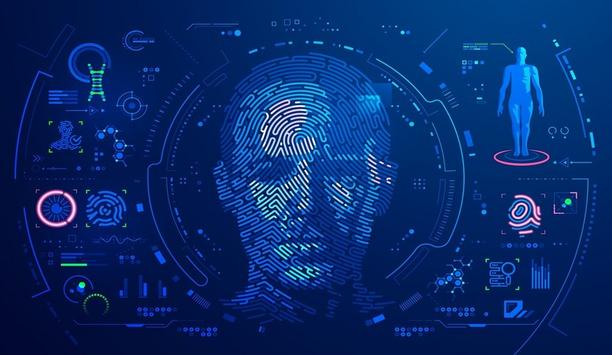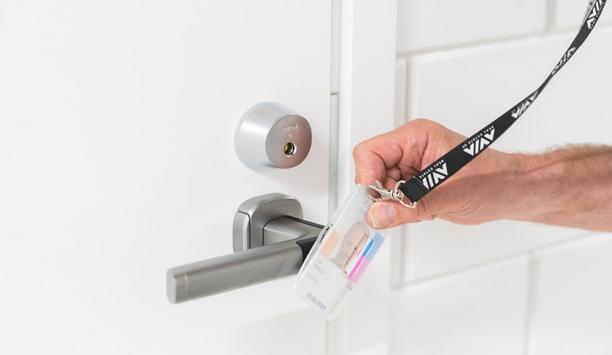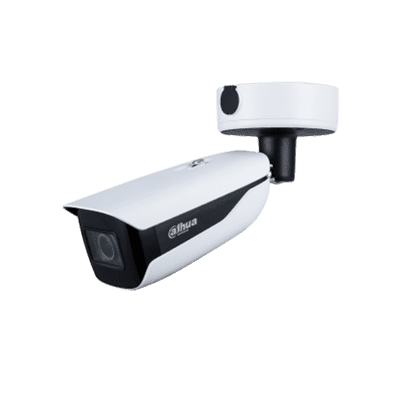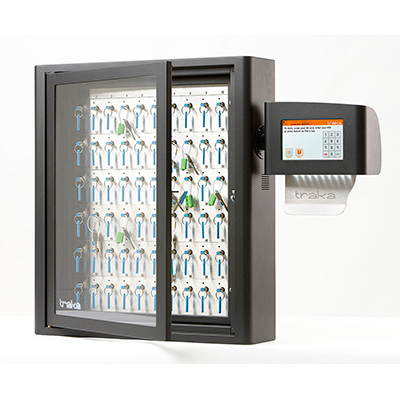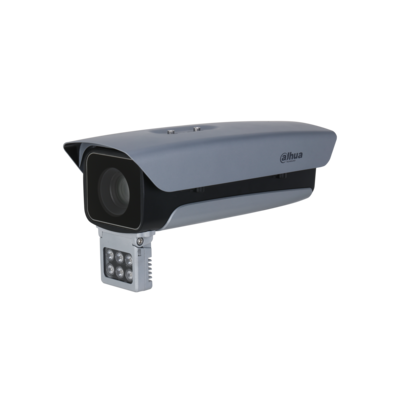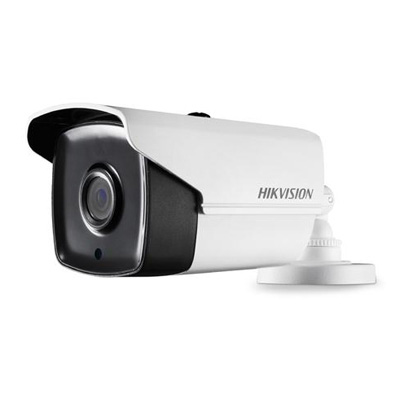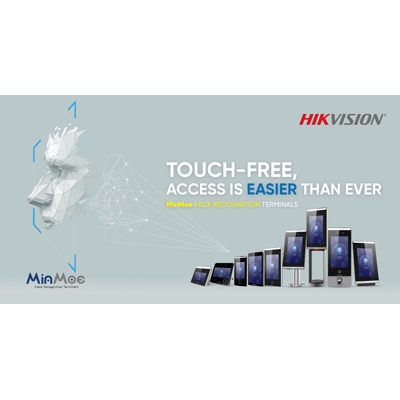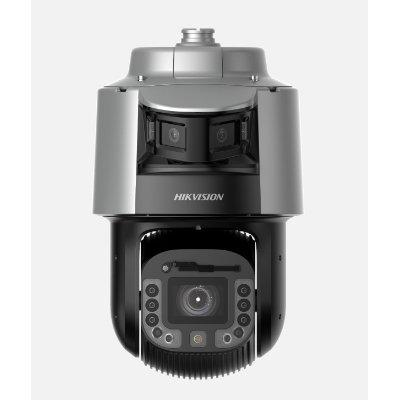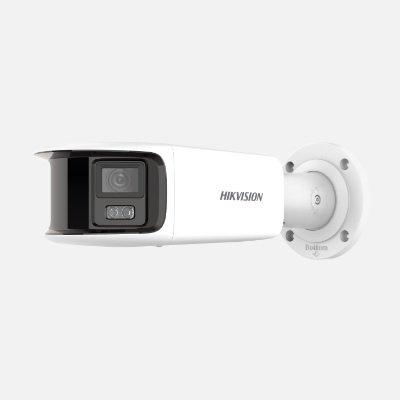Biometric Security
Smiths Detection, a pioneer in threat detection and security screening technologies, and a business of Smiths Group plc, announces it is to supply SDX 6040 X-ray inspection systems to a number of major cruise lines. With thousands of people and large quantities of cargo coming onboard, screening systems are vital in helping detect weapons, explosives, drugs, and other prohibited items hidden in luggage or supplies. SDX 6040’s portable and flexible design SDX 6040’s portable and fl...
Allegion US, a major provider of security solutions, technology and services, is thrilled to announce its participation in the Data Center World Conference 2025, taking place from April 14-17, 2025 in Washington, DC, at the Walter E. Washington Convention Center. The event will gather more than 400 industry experts from around the globe, and Allegion is poised to make a significant impact with its dedicated team of data centre experts. Allegion to exhibit at Data Center World Conference 2025...
Gcore, the global edge AI, cloud, network, and security solutions provider, has launched Super Transit, a cutting-edge DDoS protection and acceleration feature, designed to safeguard enterprise infrastructure while delivering lightning-fast connectivity. This comes as organisations face a 56% year-on-year increase in high-volume, complex DDoS attacks that disrupt operations, increase latency, and compromise network security. Gcore DDoS Protection Suite Using th...
Safetrust has been named the 2025 winner of the Access Control Software, Hardware, Devices & Peripherals – Wired category at the SIA New Products and Solutions (NPS) Awards for its IoT Neural Sensor. Safetrust was honoured during an award ceremony at the Bridge Stage on the ISC West show floor. Presented in partnership with ISC West, the NPS Awards are the Security Industry Association (SIA) flagship program, recognising the year’s most innovative security products, services, an...
PACOM, a pioneering provider of integrated security and business management solutions, will highlight its next-generation cloud-based platform VIGIL CORE at The Security Event 2025. The scalable security solution combines access control, intrusion alarm, video verification, building management and centralised alarm monitoring in one system. VIGIL CORE VIGIL CORE is an attractive choice for security and business operations professionals VIGIL CORE is an attractive choice for security...
NEXT Biometrics, the world pioneer in advanced high-security fingerprint sensor technology, has received the first major purchase order for its FAP 20 sensor in Nigeria. NEXT has already delivered an initial order of NOK 1.7 million during the first quarter of 2025. The NEXT FAP 20 sensor offers unparalleled performance and reliability, setting a new standard for secure identity verification. Integrated into POS terminals Sensor will be integrated into POS terminals to bring strong authentica...
News
Effective collaboration between security operators, teams, and other departments is essential for the smooth functioning of any organisation. However, as organisations grow in complexity, it becomes increasingly challenging for teams to coordinate. Factors such as staffing shortages, high turnover rates, and outdated collaboration tools exacerbate these challenges. Streamlining security operations These solutions enhance communication, boosts productivity, and improves overall operational efficiencyWhen staff rely on multiple disconnected tools for dispatch, reporting, and task tracking, operations often become fragmented, leading to delays and gaps in communication. In critical areas like safety and security, these inefficiencies can have serious consequences. Work management solutions bridge these gaps by managing, tracking, and documenting activities, streamlining processes, and fostering real-time collaboration. Built specifically for security teams, these solutions enhance communication, boosts productivity, and improves overall operational efficiency through workflow automation. Organisations in the Middle East operate in high-security environments where seamless collaboration is essential. Unified security approach A robust work management platform enables swift response and coordination across complex operational landscapes. This growing need for integration is driving more organisations to align their security and IT departments. According to a recent Genetec report, 78% of end users in the META region indicate that these departments now work collaboratively, reflecting a shift toward a more unified security approach. Overcoming barriers A digital work management platform consolidates these fragmented systems offering teams a unified viewOver time, many organisations accumulate a patchwork of databases, spreadsheets, and standalone systems to communicate, create reports, and track activities. Some still rely on outdated paper-and-pen processes, which aren’t only time-consuming but also prone to errors. These disjointed methods hinder information sharing and coordination. A digital work management platform consolidates these fragmented systems, offering teams a unified view of activities accessible on both desktop and mobile devices. To take full advantage of their security system data, security teams need to consider more than a generic work management solution. Smart security management An ideal work management solution for security teams should accommodate security activities such as guard tours, patrols, and maintenance inspections. It should also seamlessly integrate with existing security systems. For instance, a video operator should be able to create a work request with an attached camera snapshot and route it to the appropriate team in just a few clicks. To ensure trustworthy audits and reporting, the work management system should be built with strong cybersecurity measures and ensure that data can’t be manipulated after the fact by applying blockchain principles. Benefits of work management systems Implementing a work management system can transform security operations in several ways: Improved Communication: Teams gain real-time visibility into task progress, responsibilities, and pending assignments. Updates and alerts can be shared seamlessly to request assistance or provide situational awareness. Enhanced Collaboration: Every team member contributes to shared goals rather than isolated tasks. Custom API integrations can connect with other systems, such as employee apps, further fostering teamwork. Time Savings: Built-in reporting tools automate activity logs and compliance audits, freeing up time for other critical tasks. Operational Efficiency: Routine tasks, incident management, and resource tracking are streamlined. Tasks are assigned to personnel with the appropriate skills, tools, and knowledge, ensuring readiness and precision. Workflow Automation: Automations simplify recurring tasks, such as setting reminders, generating reports, or notifying team leads when new requests are added. Resource Optimisation: Features like work ticketing and asset management enable efficient resource allocation and management of internal and external requests. Mobile Support: Field officers benefit from mobile apps that enhance situational awareness, communication, and access to standard operating procedures on the go. Today, governments across the region, including the UAE and Saudi Arabia, are heavily investing in smart security solutions as part of their national digital transformation strategies. A centralised work management platform not only supports these efforts but also helps businesses align with evolving security regulations, ensuring compliance and streamlining reporting processes. Tips for successful implementation Every organisation has unique workflows, so selecting a customisable work management system is crucial. It’s important to choose a solution that’s customisable and intuitive to minimise the need for extensive training. Integration is another key factor. A platform that deeply integrates with your existing security ecosystem provides a cohesive view of operations and eliminates the need for manual data transfers or redundant processes. A well-designed work management system can break down silos, empower teams, and boost efficiency. To ensure a successful deployment, adopt a lean and agile approach: start small and gradually incorporate more features as your team becomes comfortable with the platform. With initiatives like Saudi Vision 2030 and UAE’s Smart City strategy, organisations are increasingly integrating AI-driven security and IoT-enabled monitoring into their operations. A work management platform with automation capabilities supports these advanced security frameworks.
Motorola Solutions announced the new Pelco, an innovative portfolio of artificial-intelligence-powered devices that are purpose-built for enterprises operating in some of the most challenging environments, like oil and gas and ports. Backed by the company’s deep engineering expertise and significant investments in research and development. Smart surveillance The portfolio brings together specialised security technologies from the strategic acquisitions of VideotecPelco’s device lineup features fixed cameras, ruggedised and long-range cameras, smart sensors and AI analytics that easily integrate with a broad set of third-party video management systems (VMS). Since acquiring Pelco in 2020, Motorola Solutions has completely transformed the camera line, which has more than doubled in breadth since the company brought engineering and design in-house. Under a contemporary new Pelco mark, the portfolio brings together specialised security technologies from the strategic acquisitions of Videotec, IP Video and Silent Sentinel. Advanced threat detection “Pelco provides security operators with robust AI-powered security solutions capable of performing across a wide range of environmental conditions,” said Hamish Dobson, corporate vice president, Pelco. “We’ve purposefully created Pelco to combine rugged hardware, state-of-the-art sensing and AI-powered analytics for a VMS-agnostic device portfolio that is driving higher standards in critical infrastructure security.” Expanding security solutions Expansions to the portfolio broaden growth opportunities with enterprises and critical infrastructure verticals like transportation, aviation, maritime and utilities. Such operations routinely endure extreme weather, corrosive elements and other hazardous conditions where standard security cameras and devices would quickly be damaged. Precision in protection Pelco’s new specialised portfolio includes: Esprit Anti-Corrosion cameras that can withstand the harsh elements of maritime environments. The ExSite Enhanced Thermal 2 fixed camera, which gives hazardous sites like power plants a thermal imaging security camera with global explosion-proof certifications. The Halo Smart Sensor, an all-in-one intelligent sensor that protects privacy while detecting events like vaping, gunshots, abnormal noises, motion and emergency keywords like “help.” The Aeron and Jaegar cameras, which offer detection capabilities at distances of up to 20 miles in extreme environments associated with military, aviation, maritime and critical infrastructure. All Pelco devices are supported by Elevate, a cloud-based camera support platform. Elevate assesses camera health and expands the sensing capabilities of the camera with cloud-based AI. Future-ready surveillance Pelco devices are engineered to be compatible with Open Network Video Interface Forum (ONVIF) -conformant systems, simplifying installation, enabling flexible integrations and alleviating costly system overhauls. Pelco IP cameras enable regulatory compliance with the current National Defense Authorisation Act (NDAA) Sec. 889 rules for the procurement of secure equipment. Experience the new Pelco at booth #14059 at ISC West from April 2-4 in Las Vegas.
Kollmorgen servo motors are now available with our fourth-generation SFD-M smart feedback device. Offered at no additional cost over Kollmorgen’s earlier SFD models, this encoder offers four times greater positioning accuracy and uses energy-harvesting technology to track absolute multi-turn positioning even when the system is powered off. Revolutionising motion feedback SFD-M allows machine builders to achieve high-resolution multi-turn feedbackKollmorgen, a global pioneer in motion control and automation systems, introduced the new SFD-M (Smart Feedback Device, Multi-Turn). It allows machine builders to achieve high-resolution multi-turn feedback with absolute positioning information available at system startup. Designed to work with AKDTM and AKD2G drives, the SFD-M absolute multi-turn encoder can be integrated into Kollmorgen housed servo motors at no additional charge compared to the SFD-3 single-turn absolute encoder, providing multi-turn performance, four times greater positioning accuracy and fifty times lower EMFnoise. Comparable third-party encoders come with a premium price. With the SFD-M, customers can achieve substantial savings in machine designs that perform at the highest levels of precision, efficiency and effectiveness. Absolute multi-turn positioning The SFD-M measures the position of the rotor shaft throughout each 360º rotation without requiring reference to a home position, and it registers the total number of rotations the shaft has made in either direction. This absolute multi-turn positioning capability is ideal when precise tracking of position is required over large rotational distances, such as in machine tool positioning, packaging machines, material handling, satellite tracking and many other applications. Additionally, the SFD-M maintains absolute positioning information in real time even when the system is powered down, eliminating the need for time-consuming homing sequences upon startup. Battery-free operation Battery-free operation eliminates maintenance issues while also supporting efforts to reduce the consumptionAbsolute multi-turn encoders from other providers often require a battery to retain positioning information when the system is powered down or during a power failure. These external batteries require replacement and can be subject to failure. Other alternatives use mechanical gear trains, which are noisy, backlash-prone and add size to the motor. The new Kollmorgen SFD-M eliminates these issues, instead using energy-harvesting technology to reliably maintain positioning information with no need for batteries or gear trains. Battery-free operation eliminates maintenance issues while also supporting efforts to reduce the consumption of natural resources and minimise waste. Exceptional performance at an exceptional value The SFD-M is highly accurate, offering these key specifications: Resolution 24 bits per revolution 16,777,216 counts per revolution 0.0772 arc-sec per count Multi-turn absolute range 16 bits = 65,536 motor revolutions Multi-turn absolute range 16 bits = 65,536 motor revolutions Accuracy < +/– 1 arc-min typical at 25ºC < +/– 3 arc-min worst case Breakthrough in motion “Our new SFD-M encoder provides multi-turn absolute functionality with exceptional position accuracy and resolution at zero additional cost over Kollmorgen motors with single-turn encoders,” said Chris Cooper, Kollmorgen’s Senior Director of Global Product Management. “That’s a huge benefit for precision and productivity at a savings of hundreds of dollars per motor and potentially several thousand dollars in a complex, multi-axis machine. Single motor-to-drive cable technology with auto drive setup further lowers total costs. We are very proud to offer all of these benefits to our customers as an integral part of Kollmorgen’s industry-leading servo systems.”
Aiphone, the global pioneer in security communication and access control solutions, will showcase its latest solutions at ISC West 2025, including major updates for AiphoneCloud’s innovative dashboard and Remote Management for commercial applications as well as new AC Series cloud deployment options. Attendees visiting booth #6109 can get first-hand demonstrations of the platform’s remote management capabilities and the complete range of intercom and access control solutions tailored to the unique need of each vertical. Development with remote management The updated Remote Management delivers faster, more secure, and more efficient system deployment The improved AiphoneCloud includes a more intuitive user interface, enhanced efficiency, and comprehensive function updates. These enhancements enable security professionals to streamline every aspect of their relationship with Aiphone, from pre-sales support to product deployment and post-installation account management. The updated Remote Management delivers faster, more secure, and more efficient system deployment. Technicians and integrators can now access the powerful remote capabilities to configure, monitor, and manage Aiphone IP intercom systems from anywhere at any time. Smart, scalable protection “In an increasingly complicated and unpredictable world, simplicity is no longer a luxury, it’s a necessity.” said Sean Peterson, Director of Product, Marketing and Support at Aiphone. "Our enhanced cloud solution represents Aiphone's commitment to delivering flexible, scalable security solutions built for the future." Next-gen access control Building on its cloud momentum, Aiphone is introducing AC Nio cloud hosting option at ISC West, scheduled for release in late April 2025. AC Nio in the cloud makes it a complete, modern access control solution ready to make waves in the industry. The AC Series features a powerful, intuitive dashboard for managing permissions, schedules, and alerts with exceptional scalability and customisation options. Its Nio Scripting Engine enables third-party API integration and event customisation. When combined with intercoms, video management solutions, and wireless locks, the system creates a unified security ecosystem with cloud deployment flexibility to meet evolving security needs. Enhance building access control As the only brand in the industry offering four telephone entry solutions, Aiphone continues to revolutionise access control for multifamily, mixed-use buildings, and commercial properties. Flexible entry options include tenant station door release, mobile app, telephone dialing via SIM, and SIP integration. Each option allows users to see and communicate with visitors before granting entry with the press of a button, enhancing both convenience and security.
Integrated Control Technology a pioneer manufacturer of intelligent access control and security solutions, announced the release of their new TSL access reader series. The new TSL range packs plenty of extras into a slimmed down version of the much-loved ICT readers. Style meets security TSL delivers a dynamic solution for property managers, security professionals, and building operatorsCombining sleek aesthetics with cutting-edge functionality, the TSL delivers a dynamic solution for property managers, security professionals, and building operators seeking a future-proof system for secure and efficient building access. Designed to meet diverse needs, the TSL readers are available in three sizes with a choice of black or white finishes and optional keypads, ensuring it complements any property’s aesthetic while delivering matchless performance. Perfectly tailored for modern buildings. Advanced access control benefits Key benefits include: Hassle-Free Installation: The Quick Connect Plug and app-based configuration enables fast installation. Future-proof: Stay current with live over-the-network firmware updates for future formats, functionality, features, and security enhancements. Customisable Aesthetics: Pick from 3 sizes, 2 finishes, and optional keypads. Visual Feedback at a Glance: Signal access status with 16 configurable LED colours Credential Flexibility: Supports an unmatched number of existing credential types, along with Bluetooth® and NFC capabilities. Unparalleled Security: Advanced encryption-dedicated hardware: Secure Access Module (SAM) handling all credential encryption tasks and key management. Built to Last: IP65-rated for harsh environments and vandal-resistant options for enhanced security. Seamless security innovation Armando Morles, Product Manager at ICT, had the following to say about the product launch, “The new TSL access reader series provides our customers and their end-users with a seamless blend of style, user-friendly customisation, technology and advanced capabilities.”
iDenfy, a global pioneer in identity verification and fraud prevention, announced a new partnership with Coast, an innovative blockchain platform simplifying crypto-to-fiat transactions on PulseChain. This partnership will focus on enhancing security and streamlining KYC/AML compliance processes while boosting the platform’s security and addressing critical challenges in the blockchain ecosystem. Securing decentralised finance This partnership represents a crucial step forward, equipping Coast with advanced tools Global money laundering remains a common issue, with an estimated $2. trillion laundered annually, according to the United Nations. As financial crimes grow, platforms operating at the intersection of blockchain and traditional finance face increasing pressure to meet stringent compliance standards. This partnership represents a crucial step forward, equipping Coast with advanced tools to navigate the complexities of regulatory frameworks while fostering trust and security in the decentralised finance sector. Blockchain security simplified Coast has established itself as a pioneer in blockchain technology and financial services by offering a seamless and compliant gateway for users to interact with PulseChain. The platform's mission is to create user-centric financial solutions tailored for the decentralised future while maintaining the highest standards of security and compliance. To achieve this, Coast has partnered with iDenfy, a company known for its robust identity verification and Anti-Money Laundering (AML) tools that meet global compliance requirements. Secure identity verification Through this collaboration, iDenfy will bring its innovative identity verification solution, ensuring precise and secure onboarding for all users. iDenfy’s technology automatically recognises, verifies, and extracts information from more than 3,000 types of identity documents across more than 200 countries and territories. From passports and ID cards to driving licences and residence permits. The solution also includes the integration of iDenfy’s advanced biometric facial recognition and 3D liveness detection technology to prevent fraudulent activities, such as the use of fake images, face masks, or digital renderings. By creating three-dimensional facial maps, iDenfy provides a secure method for user authentication, ensuring the verification process is both seamless and bulletproof. Scalable fraud prevention Coast can now conduct ongoing monitoring and receive instant notifications of any AML risk hits during the KYC process The partnership offers Coast a scalable system that reduces onboarding time while ensuring full compliance with global AML regulations. This includes screening users against sanctions lists, Politically Exposed Persons (PEPs), watchlists, and adverse media sources. By integrating iDenfy’s technology, Coast can now conduct ongoing monitoring and receive instant notifications of any AML risk hits during the KYC process. iDenfy’s solutions have already transformed Coast’s operations, offering a near-perfect verification success rate of 99.99%. Secure and compliant The high level of accuracy is supported by a team of expert reviewers who oversee all automated ID verifications to eliminate potential system errors, fraud attempts, or failures. In addition to its technological capabilities, iDenfy’s software is fully compliant with GDPR, CCPA, and SOC 2 standards, ensuring that businesses can operate with confidence in its data security and privacy practices. Providing financial security For Coast, the ability to deliver a seamless onboarding experience without compromising security is a top priority. The platform aims to bridge the gap between traditional financial systems and blockchain technology, empowering users to interact with decentralised systems easily and securely. With iDenfy’s solutions, Coast has not only improved its onboarding process but also enhanced user trust by ensuring compliance with the latest global regulations. Before partnering with iDenfy, Coast faced challenges in delivering a fast, user-friendly identity verification process while maintaining robust security standards. Innovation in verification iDenfy’s scalable solutions have resolved these issues, significantly improving operational efficiency and user trust. This partnership aligns perfectly with the mission to create a seamless and inclusive experience for PulseChain. Domantas Ciulde, CEO of iDenfy, said, “Blockchain platforms like Coast are paving the way for the future of finance. Our advanced identity verification and AML screening tools ensure that Coast’s users can confidently engage with PulseChain while maintaining compliance with global regulations. We’re proud to support Coast in creating a secure and innovative platform.” Faster and safer onboarding The integration of iDenfy’s tools has also transformed the user experience for Coast’s clients. The streamlined KYC process is now a simple, three-step procedure that takes less than a minute on average to complete. This efficiency ensures that users can quickly access Coast’s services without unnecessary delays, positioning the platform as a pioneer in user-centric blockchain solutions.
Effective collaboration between security operators, teams, and other departments is essential for the smooth functioning of any organisation. However, as organisations grow in complexity, it becomes increasingly challenging for teams to coordinate. Factors such as staffing shortages, high turnover rates, and outdated collaboration tools exacerbate these challenges. Streamlining security operations These solutions enhance communication, boosts productivity, and improves overall operational efficiencyWhen staff rely on multiple disconnected tools for dispatch, reporting, and task tracking, operations often become fragmented, leading to delays and gaps in communication. In critical areas like safety and security, these inefficiencies can have serious consequences. Work management solutions bridge these gaps by managing, tracking, and documenting activities, streamlining processes, and fostering real-time collaboration. Built specifically for security teams, these solutions enhance communication, boosts productivity, and improves overall operational efficiency through workflow automation. Organisations in the Middle East operate in high-security environments where seamless collaboration is essential. Unified security approach A robust work management platform enables swift response and coordination across complex operational landscapes. This growing need for integration is driving more organisations to align their security and IT departments. According to a recent Genetec report, 78% of end users in the META region indicate that these departments now work collaboratively, reflecting a shift toward a more unified security approach. Overcoming barriers A digital work management platform consolidates these fragmented systems offering teams a unified viewOver time, many organisations accumulate a patchwork of databases, spreadsheets, and standalone systems to communicate, create reports, and track activities. Some still rely on outdated paper-and-pen processes, which aren’t only time-consuming but also prone to errors. These disjointed methods hinder information sharing and coordination. A digital work management platform consolidates these fragmented systems, offering teams a unified view of activities accessible on both desktop and mobile devices. To take full advantage of their security system data, security teams need to consider more than a generic work management solution. Smart security management An ideal work management solution for security teams should accommodate security activities such as guard tours, patrols, and maintenance inspections. It should also seamlessly integrate with existing security systems. For instance, a video operator should be able to create a work request with an attached camera snapshot and route it to the appropriate team in just a few clicks. To ensure trustworthy audits and reporting, the work management system should be built with strong cybersecurity measures and ensure that data can’t be manipulated after the fact by applying blockchain principles. Benefits of work management systems Implementing a work management system can transform security operations in several ways: Improved Communication: Teams gain real-time visibility into task progress, responsibilities, and pending assignments. Updates and alerts can be shared seamlessly to request assistance or provide situational awareness. Enhanced Collaboration: Every team member contributes to shared goals rather than isolated tasks. Custom API integrations can connect with other systems, such as employee apps, further fostering teamwork. Time Savings: Built-in reporting tools automate activity logs and compliance audits, freeing up time for other critical tasks. Operational Efficiency: Routine tasks, incident management, and resource tracking are streamlined. Tasks are assigned to personnel with the appropriate skills, tools, and knowledge, ensuring readiness and precision. Workflow Automation: Automations simplify recurring tasks, such as setting reminders, generating reports, or notifying team leads when new requests are added. Resource Optimisation: Features like work ticketing and asset management enable efficient resource allocation and management of internal and external requests. Mobile Support: Field officers benefit from mobile apps that enhance situational awareness, communication, and access to standard operating procedures on the go. Today, governments across the region, including the UAE and Saudi Arabia, are heavily investing in smart security solutions as part of their national digital transformation strategies. A centralised work management platform not only supports these efforts but also helps businesses align with evolving security regulations, ensuring compliance and streamlining reporting processes. Tips for successful implementation Every organisation has unique workflows, so selecting a customisable work management system is crucial. It’s important to choose a solution that’s customisable and intuitive to minimise the need for extensive training. Integration is another key factor. A platform that deeply integrates with your existing security ecosystem provides a cohesive view of operations and eliminates the need for manual data transfers or redundant processes. A well-designed work management system can break down silos, empower teams, and boost efficiency. To ensure a successful deployment, adopt a lean and agile approach: start small and gradually incorporate more features as your team becomes comfortable with the platform. With initiatives like Saudi Vision 2030 and UAE’s Smart City strategy, organisations are increasingly integrating AI-driven security and IoT-enabled monitoring into their operations. A work management platform with automation capabilities supports these advanced security frameworks.
Motorola Solutions announced the new Pelco, an innovative portfolio of artificial-intelligence-powered devices that are purpose-built for enterprises operating in some of the most challenging environments, like oil and gas and ports. Backed by the company’s deep engineering expertise and significant investments in research and development. Smart surveillance The portfolio brings together specialised security technologies from the strategic acquisitions of VideotecPelco’s device lineup features fixed cameras, ruggedised and long-range cameras, smart sensors and AI analytics that easily integrate with a broad set of third-party video management systems (VMS). Since acquiring Pelco in 2020, Motorola Solutions has completely transformed the camera line, which has more than doubled in breadth since the company brought engineering and design in-house. Under a contemporary new Pelco mark, the portfolio brings together specialised security technologies from the strategic acquisitions of Videotec, IP Video and Silent Sentinel. Advanced threat detection “Pelco provides security operators with robust AI-powered security solutions capable of performing across a wide range of environmental conditions,” said Hamish Dobson, corporate vice president, Pelco. “We’ve purposefully created Pelco to combine rugged hardware, state-of-the-art sensing and AI-powered analytics for a VMS-agnostic device portfolio that is driving higher standards in critical infrastructure security.” Expanding security solutions Expansions to the portfolio broaden growth opportunities with enterprises and critical infrastructure verticals like transportation, aviation, maritime and utilities. Such operations routinely endure extreme weather, corrosive elements and other hazardous conditions where standard security cameras and devices would quickly be damaged. Precision in protection Pelco’s new specialised portfolio includes: Esprit Anti-Corrosion cameras that can withstand the harsh elements of maritime environments. The ExSite Enhanced Thermal 2 fixed camera, which gives hazardous sites like power plants a thermal imaging security camera with global explosion-proof certifications. The Halo Smart Sensor, an all-in-one intelligent sensor that protects privacy while detecting events like vaping, gunshots, abnormal noises, motion and emergency keywords like “help.” The Aeron and Jaegar cameras, which offer detection capabilities at distances of up to 20 miles in extreme environments associated with military, aviation, maritime and critical infrastructure. All Pelco devices are supported by Elevate, a cloud-based camera support platform. Elevate assesses camera health and expands the sensing capabilities of the camera with cloud-based AI. Future-ready surveillance Pelco devices are engineered to be compatible with Open Network Video Interface Forum (ONVIF) -conformant systems, simplifying installation, enabling flexible integrations and alleviating costly system overhauls. Pelco IP cameras enable regulatory compliance with the current National Defense Authorisation Act (NDAA) Sec. 889 rules for the procurement of secure equipment. Experience the new Pelco at booth #14059 at ISC West from April 2-4 in Las Vegas.
Kollmorgen servo motors are now available with our fourth-generation SFD-M smart feedback device. Offered at no additional cost over Kollmorgen’s earlier SFD models, this encoder offers four times greater positioning accuracy and uses energy-harvesting technology to track absolute multi-turn positioning even when the system is powered off. Revolutionising motion feedback SFD-M allows machine builders to achieve high-resolution multi-turn feedbackKollmorgen, a global pioneer in motion control and automation systems, introduced the new SFD-M (Smart Feedback Device, Multi-Turn). It allows machine builders to achieve high-resolution multi-turn feedback with absolute positioning information available at system startup. Designed to work with AKDTM and AKD2G drives, the SFD-M absolute multi-turn encoder can be integrated into Kollmorgen housed servo motors at no additional charge compared to the SFD-3 single-turn absolute encoder, providing multi-turn performance, four times greater positioning accuracy and fifty times lower EMFnoise. Comparable third-party encoders come with a premium price. With the SFD-M, customers can achieve substantial savings in machine designs that perform at the highest levels of precision, efficiency and effectiveness. Absolute multi-turn positioning The SFD-M measures the position of the rotor shaft throughout each 360º rotation without requiring reference to a home position, and it registers the total number of rotations the shaft has made in either direction. This absolute multi-turn positioning capability is ideal when precise tracking of position is required over large rotational distances, such as in machine tool positioning, packaging machines, material handling, satellite tracking and many other applications. Additionally, the SFD-M maintains absolute positioning information in real time even when the system is powered down, eliminating the need for time-consuming homing sequences upon startup. Battery-free operation Battery-free operation eliminates maintenance issues while also supporting efforts to reduce the consumptionAbsolute multi-turn encoders from other providers often require a battery to retain positioning information when the system is powered down or during a power failure. These external batteries require replacement and can be subject to failure. Other alternatives use mechanical gear trains, which are noisy, backlash-prone and add size to the motor. The new Kollmorgen SFD-M eliminates these issues, instead using energy-harvesting technology to reliably maintain positioning information with no need for batteries or gear trains. Battery-free operation eliminates maintenance issues while also supporting efforts to reduce the consumption of natural resources and minimise waste. Exceptional performance at an exceptional value The SFD-M is highly accurate, offering these key specifications: Resolution 24 bits per revolution 16,777,216 counts per revolution 0.0772 arc-sec per count Multi-turn absolute range 16 bits = 65,536 motor revolutions Multi-turn absolute range 16 bits = 65,536 motor revolutions Accuracy < +/– 1 arc-min typical at 25ºC < +/– 3 arc-min worst case Breakthrough in motion “Our new SFD-M encoder provides multi-turn absolute functionality with exceptional position accuracy and resolution at zero additional cost over Kollmorgen motors with single-turn encoders,” said Chris Cooper, Kollmorgen’s Senior Director of Global Product Management. “That’s a huge benefit for precision and productivity at a savings of hundreds of dollars per motor and potentially several thousand dollars in a complex, multi-axis machine. Single motor-to-drive cable technology with auto drive setup further lowers total costs. We are very proud to offer all of these benefits to our customers as an integral part of Kollmorgen’s industry-leading servo systems.”
Aiphone, the global pioneer in security communication and access control solutions, will showcase its latest solutions at ISC West 2025, including major updates for AiphoneCloud’s innovative dashboard and Remote Management for commercial applications as well as new AC Series cloud deployment options. Attendees visiting booth #6109 can get first-hand demonstrations of the platform’s remote management capabilities and the complete range of intercom and access control solutions tailored to the unique need of each vertical. Development with remote management The updated Remote Management delivers faster, more secure, and more efficient system deployment The improved AiphoneCloud includes a more intuitive user interface, enhanced efficiency, and comprehensive function updates. These enhancements enable security professionals to streamline every aspect of their relationship with Aiphone, from pre-sales support to product deployment and post-installation account management. The updated Remote Management delivers faster, more secure, and more efficient system deployment. Technicians and integrators can now access the powerful remote capabilities to configure, monitor, and manage Aiphone IP intercom systems from anywhere at any time. Smart, scalable protection “In an increasingly complicated and unpredictable world, simplicity is no longer a luxury, it’s a necessity.” said Sean Peterson, Director of Product, Marketing and Support at Aiphone. "Our enhanced cloud solution represents Aiphone's commitment to delivering flexible, scalable security solutions built for the future." Next-gen access control Building on its cloud momentum, Aiphone is introducing AC Nio cloud hosting option at ISC West, scheduled for release in late April 2025. AC Nio in the cloud makes it a complete, modern access control solution ready to make waves in the industry. The AC Series features a powerful, intuitive dashboard for managing permissions, schedules, and alerts with exceptional scalability and customisation options. Its Nio Scripting Engine enables third-party API integration and event customisation. When combined with intercoms, video management solutions, and wireless locks, the system creates a unified security ecosystem with cloud deployment flexibility to meet evolving security needs. Enhance building access control As the only brand in the industry offering four telephone entry solutions, Aiphone continues to revolutionise access control for multifamily, mixed-use buildings, and commercial properties. Flexible entry options include tenant station door release, mobile app, telephone dialing via SIM, and SIP integration. Each option allows users to see and communicate with visitors before granting entry with the press of a button, enhancing both convenience and security.
Integrated Control Technology a pioneer manufacturer of intelligent access control and security solutions, announced the release of their new TSL access reader series. The new TSL range packs plenty of extras into a slimmed down version of the much-loved ICT readers. Style meets security TSL delivers a dynamic solution for property managers, security professionals, and building operatorsCombining sleek aesthetics with cutting-edge functionality, the TSL delivers a dynamic solution for property managers, security professionals, and building operators seeking a future-proof system for secure and efficient building access. Designed to meet diverse needs, the TSL readers are available in three sizes with a choice of black or white finishes and optional keypads, ensuring it complements any property’s aesthetic while delivering matchless performance. Perfectly tailored for modern buildings. Advanced access control benefits Key benefits include: Hassle-Free Installation: The Quick Connect Plug and app-based configuration enables fast installation. Future-proof: Stay current with live over-the-network firmware updates for future formats, functionality, features, and security enhancements. Customisable Aesthetics: Pick from 3 sizes, 2 finishes, and optional keypads. Visual Feedback at a Glance: Signal access status with 16 configurable LED colours Credential Flexibility: Supports an unmatched number of existing credential types, along with Bluetooth® and NFC capabilities. Unparalleled Security: Advanced encryption-dedicated hardware: Secure Access Module (SAM) handling all credential encryption tasks and key management. Built to Last: IP65-rated for harsh environments and vandal-resistant options for enhanced security. Seamless security innovation Armando Morles, Product Manager at ICT, had the following to say about the product launch, “The new TSL access reader series provides our customers and their end-users with a seamless blend of style, user-friendly customisation, technology and advanced capabilities.”
iDenfy, a global pioneer in identity verification and fraud prevention, announced a new partnership with Coast, an innovative blockchain platform simplifying crypto-to-fiat transactions on PulseChain. This partnership will focus on enhancing security and streamlining KYC/AML compliance processes while boosting the platform’s security and addressing critical challenges in the blockchain ecosystem. Securing decentralised finance This partnership represents a crucial step forward, equipping Coast with advanced tools Global money laundering remains a common issue, with an estimated $2. trillion laundered annually, according to the United Nations. As financial crimes grow, platforms operating at the intersection of blockchain and traditional finance face increasing pressure to meet stringent compliance standards. This partnership represents a crucial step forward, equipping Coast with advanced tools to navigate the complexities of regulatory frameworks while fostering trust and security in the decentralised finance sector. Blockchain security simplified Coast has established itself as a pioneer in blockchain technology and financial services by offering a seamless and compliant gateway for users to interact with PulseChain. The platform's mission is to create user-centric financial solutions tailored for the decentralised future while maintaining the highest standards of security and compliance. To achieve this, Coast has partnered with iDenfy, a company known for its robust identity verification and Anti-Money Laundering (AML) tools that meet global compliance requirements. Secure identity verification Through this collaboration, iDenfy will bring its innovative identity verification solution, ensuring precise and secure onboarding for all users. iDenfy’s technology automatically recognises, verifies, and extracts information from more than 3,000 types of identity documents across more than 200 countries and territories. From passports and ID cards to driving licences and residence permits. The solution also includes the integration of iDenfy’s advanced biometric facial recognition and 3D liveness detection technology to prevent fraudulent activities, such as the use of fake images, face masks, or digital renderings. By creating three-dimensional facial maps, iDenfy provides a secure method for user authentication, ensuring the verification process is both seamless and bulletproof. Scalable fraud prevention Coast can now conduct ongoing monitoring and receive instant notifications of any AML risk hits during the KYC process The partnership offers Coast a scalable system that reduces onboarding time while ensuring full compliance with global AML regulations. This includes screening users against sanctions lists, Politically Exposed Persons (PEPs), watchlists, and adverse media sources. By integrating iDenfy’s technology, Coast can now conduct ongoing monitoring and receive instant notifications of any AML risk hits during the KYC process. iDenfy’s solutions have already transformed Coast’s operations, offering a near-perfect verification success rate of 99.99%. Secure and compliant The high level of accuracy is supported by a team of expert reviewers who oversee all automated ID verifications to eliminate potential system errors, fraud attempts, or failures. In addition to its technological capabilities, iDenfy’s software is fully compliant with GDPR, CCPA, and SOC 2 standards, ensuring that businesses can operate with confidence in its data security and privacy practices. Providing financial security For Coast, the ability to deliver a seamless onboarding experience without compromising security is a top priority. The platform aims to bridge the gap between traditional financial systems and blockchain technology, empowering users to interact with decentralised systems easily and securely. With iDenfy’s solutions, Coast has not only improved its onboarding process but also enhanced user trust by ensuring compliance with the latest global regulations. Before partnering with iDenfy, Coast faced challenges in delivering a fast, user-friendly identity verification process while maintaining robust security standards. Innovation in verification iDenfy’s scalable solutions have resolved these issues, significantly improving operational efficiency and user trust. This partnership aligns perfectly with the mission to create a seamless and inclusive experience for PulseChain. Domantas Ciulde, CEO of iDenfy, said, “Blockchain platforms like Coast are paving the way for the future of finance. Our advanced identity verification and AML screening tools ensure that Coast’s users can confidently engage with PulseChain while maintaining compliance with global regulations. We’re proud to support Coast in creating a secure and innovative platform.” Faster and safer onboarding The integration of iDenfy’s tools has also transformed the user experience for Coast’s clients. The streamlined KYC process is now a simple, three-step procedure that takes less than a minute on average to complete. This efficiency ensures that users can quickly access Coast’s services without unnecessary delays, positioning the platform as a pioneer in user-centric blockchain solutions.


Expert commentary
In today's rapidly evolving security landscape, facial recognition has become a buzzword that often triggers privacy and data protection concerns. However, many security professionals may not realise that "facial recognition" is an umbrella term encompassing various technologies, each with distinct applications and privacy implications. Let's dive into what these technologies really mean for security system resellers, integrators, and end-users. Facial recognition tech At its core, facial recognition technology re-identifies or verifies individuals based on their facial features, which are used as biometrics. However, not all biometric systems are based on unique identifying features. Some analyse general characteristics like facial hair style or other distinctive marks. Such traits, known as soft biometrics, can aid in identification but aren't unique enough to verify someone's identity uniquely. Personally identifiable information Modern systems incorporate robust safeguards, including data encryption and strict retention policies While facial recognition technology has applications ranging from access control to crime prevention to investigation, its implementation varies widely depending on specific needs. Modern systems incorporate robust safeguards, including data encryption and strict retention policies, to ensure the responsible handling of any personally identifiable information (PII). Understanding key technologies and applications Facial recognition encompasses several distinct technologies, each serving specific purposes. Here's a comprehensive breakdown of these technologies and their real-world applications. Key technologies: Face Verification (1:1): A one-to-one comparison where a person claims an identity (e.g., by showing an ID card), and the system verifies whether the face matches the provided identity. Example: In airports, face verification is used for automated passport control. When a traveler approaches a gate, their face is scanned and compared to the photo stored in the government database. If the face matches, the traveler is allowed through the gate without manual checks. Face Identification (1 to many): A one-to-many comparison, where a face captured by a system is compared to a database of multiple faces and facial features to identify the person. This process is often used in security or surveillance contexts. Example: In the case of a missing child at an airport, a system could scan the faces of all passengers passing through checkpoints and compare them to a photo of the child in a database. If a match is found, it triggers an alert. Face Re-identification (Many to Many): Many-to-many comparisons where multiple faces are compared to multiple other faces. This is typically used to track a person’s movement anonymously across different areas by matching their facial images at different checkpoints, without knowing their identity. Example: In a retail environment, facial re-identification might be used to track how long an anonymous person spends moving from one section of a store to another by re-identifying their face as they enter and leave different camera views. Facial recognition can be used both for real-time and offline applications. Real-Time Facial Recognition: Real-time facial recognition refers to the immediate processing of a live video feed, comparing faces to a database to generate instant alerts when a match is found. Example: At large public events like sports stadiums, real-time facial recognition might be used to detect banned individuals (e.g., known hooligans) as they attempt to enter. Post-Event (Recorded) Facial Recognition: This refers to analysing video recordings after the event has occurred, rather than in real-time. Facial recognition is applied to recorded data to identify or track individuals. Example: After a crime, investigators could use facial recognition software on recorded video from security cameras to identify suspects by matching their faces to known databases. These definitions cover various aspects of facial recognition technology, its different applications, and how biometrics are used for identification and tracking purposes. Biometrics: Biometric technologies use a person’s distinguishing physical characteristics, such as their face, fingerprint, or iris, to identify them. Example: Fingerprint or face scanning for unlocking a phone or using iris recognition for secure entry at high-security buildings like data centers. Hard Biometrics: Hard biometrics refer to physical characteristics that are sufficiently unique enough to be used for identifying a specific individual, such as a face, fingerprint, or iris. Example: Using iris recognition at airport security checkpoints to confirm the identity of a traveler. Soft Biometrics: Soft biometrics (personal features) include general attributes like height or body shape, which are not unique enough to identify a person on their own but can help narrow down re-identification when combined with other information. Example: Using height and body shape to help identify a suspect in a camera scene when facial features alone are unreliable. Appearance Similarity: This refers to distinguishing between people based on their appearance (e.g., clothing, accessories) rather than biometric features. It’s often used for accelerated investigation and statistical analysis rather than identification. Example: A retail store may track customers based on the clothes they are wearing to monitor how long they stay in the store, without tracking their faces or personal details. Liveness Detection: A method used to determine whether the subject in front of a facial recognition system is a live human being and not a photo or a video recording. Example: In some mobile payment systems, facial recognition requires users to blink or move their head slightly to ensure they are a live person and not someone trying to use a photo for authentication. Mathematical Representation: Non-reversible mathematical representations are lists of numbers based on a person's facial image or appearance based on clothing. These numbers represent characteristics but cannot be easily used to recreate the face. Example: When an organisation stores only the mathematical representations from a face rather than an actual image, even if the data is stolen, it is nearly impossible to recreate the person’s face or use the data with another system. Privacy and security considerations Modern facial recognition systems prioritise privacy through various protective measures, moving far beyond the basic security protocols of the past. Solutions integrate multiple layers of protection designed to safeguard personal data while maintaining system effectiveness. These sophisticated privacy controls work in concert to ensure responsible data handling and comply with evolving security standards. Key protective measures include: Biometric template isolation that keeps facial recognition templates separate from other personal data, with dedicated secure storage environments. Template encryption frameworks specifically designed for biometric data, using industry-standard protocols that protect facial features during both processing and storage. Biometric data anonymisation that converts facial features into non-reversible mathematical representations – into numbers - prevents the reconstruction of original face images. Cascading deletion protocols automatically remove both raw facial data and derived biometric templates after their authorised use period. Segmented access controls that separate facial recognition administrative functions (like enrollment and template management) from regular system operation. Privacy standards The key is selecting the right tool for each application and ensuring that personal data is collected The security industry continues to evolve, finding innovative ways to balance effective surveillance with privacy protection. By understanding this comprehensive range of technologies, security professionals can better serve their clients with solutions that address specific needs while maintaining appropriate privacy standards. The key is selecting the right tool for each application and ensuring that personal data is collected only when necessary and protected when it is not. Statistical analysis and pattern recognition The variety of facial recognition applications demonstrates that not all systems require storing personal information. Many modern solutions focus on statistical analysis and pattern recognition rather than individual identification, offering powerful security benefits while respecting privacy concerns. This balance of capability and responsibility represents the future of video security technology.
The artificial intelligence revolution in physical security has arrived, transforming how we protect people, assets, and infrastructure. From smart buildings that automatically adjust access protocols based on real-time threat assessments to healthcare facilities using AI-enhanced video analytics for patient safety, these technologies are reshaping the industry landscape. But with this transformation comes a new era of regulatory oversight that security professionals must navigate carefully. Convergence of AI The convergence of powerful AI capabilities with traditional security systems has created unprecedented opportunities for enhanced protections while simultaneously raising important questions about privacy, transparency, and responsible deployment. As these technologies become more sophisticated, security professionals face the dual challenge of maximising their potential while ensuring compliance with evolving regulatory frameworks. The current state of AI in security systems By combining multiple data streams, AI creates a more comprehensive and intelligent security ecosystem Today's AI-driven security solutions extend far beyond traditional security capabilities. Modern systems can understand complex human behaviours, analyse crowd patterns in transportation hubs, detect early signs of trouble in retail environments, and even predict potential security breaches before they occur. By combining multiple data streams — video feeds, access control systems, audio detection, and various sensors — AI creates a more comprehensive and intelligent security ecosystem. Industrial applications The impact is particularly evident in integrated security operations. In healthcare settings, AI systems can simultaneously monitor patient safety, manage access control, and detect unauthorised entries, all while maintaining strict privacy protocols. In education environments, these technologies help safeguard campuses by identifying unusual behaviour patterns while respecting student privacy rights. Retail operations benefit from AI's ability to not only detect potential theft but also analyse customer flow patterns and identify operational inefficiencies. The technology's capabilities continue to expand through: Advanced anomaly detection that establishes normal activity patterns and flags deviations. Predictive analytics that forecast potential security risks before incidents occur. Natural language interfaces that allow security teams to query video data using voice or text commands. Multimodal analysis combining data from thermal cameras, LIDAR, IoT sensors, and other sources. Integration of multiple data sources Security systems are evolving into predictive platforms that can anticipate and prevent incidents These innovations represent just the beginning of AI's potential impact on security applications. As algorithms become more sophisticated and computing power increases, security systems are evolving into predictive platforms that can anticipate and prevent incidents rather than simply respond to them. The integration of multiple data sources allows for a more nuanced understanding of security situations, enabling more precise and effective responses to potential threats. Emerging regulatory frameworks The rapid advancement of AI capabilities has prompted governments worldwide to develop comprehensive regulatory frameworks. The European Union has taken the lead with its AI Act, categorising AI systems based on their potential risks and establishing strict guidelines for high-risk applications. Focus on safe, secure AI The United States is following suit, with recent executive orders focusing on safe, secure, and trustworthy AI development. These initiatives reflect growing global awareness of the need to balance technological advancement with ethical considerations and human rights protection. These regulations are reshaping how security technology providers approach development and implementation. Responsibility-by-design approach Companies must consider the entire lifecycle of their AI solutions, from initial development The focus has shifted toward a "responsibility-by-design" approach, where privacy protection, data security, and ethical considerations are built into systems from the ground up. This includes robust testing protocols, responsible data practices, and continuous monitoring of AI systems post-deployment. Companies must consider the entire lifecycle of their AI solutions, from initial development through deployment and ongoing operation. Transparency, accountability For security professionals, this regulatory evolution means adapting to new requirements around transparency, accountability, and human oversight. Security teams must document how AI systems make decisions, implement safeguards against bias, and ensure human operators maintain final authority over critical security decisions. The regulations also emphasise the importance of data protection, requiring organisations to implement strict controls over how information is collected, stored, and used within AI-powered security systems. Address challenges of AI The regulatory landscape continues to evolve, with new frameworks emerging that specifically address the unique challenges of AI in security applications. These include requirements for regular system audits, mandatory impact assessments for high-risk deployments, and specific guidelines for handling sensitive personal data in security contexts. Organisations must also develop clear procedures for addressing potential AI system errors or biases, ensuring that corrective measures can be implemented quickly when needed. Preparing for the future The challenge lies in maximising security effectiveness while maintaining transparency and public trust The security industry stands at a crucial junction where innovation meets responsibility. As AI capabilities grow more sophisticated, security professionals must balance the use of these powerful tools while adhering to evolving regulatory requirements. This balance becomes particularly critical in smart city applications, where AI systems might monitor public spaces for safety while respecting individual privacy rights. The challenge lies in maximising security effectiveness while maintaining transparency and public trust. Proactive approach Success in this new landscape requires a proactive approach. Security teams should invest in understanding both the technical capabilities and regulatory implications of their AI systems. This includes developing clear protocols for data handling, establishing robust testing procedures, and implementing continuous monitoring systems that can detect and address potential issues before they become problems. Organisations must also create comprehensive training programs to ensure security personnel understand both the capabilities and limitations of AI-powered systems. Human-in-the-loop approach The human element remains crucial. While AI can process vast amounts of data and identify patterns beyond human capability, security professionals must maintain oversight and final decision-making authority. This "human-in-the-loop" approach ensures that AI serves as a powerful tool for augmenting human judgment rather than replacing it. Training and education become increasingly important as security teams must understand not only how to operate AI-enhanced systems but also how to interpret their outputs and make informed decisions based on AI-generated insights. An ever-evolving environment The integration of emerging technologies like large language models and computer vision will create new opportunities Looking ahead, the security industry will likely see continued evolution in both AI capabilities and regulatory requirements. Future systems may incorporate more advanced predictive capabilities, enhanced natural language processing, and improved ability to understand complex human behaviours. However, these advancements will need to develop within an increasingly structured regulatory framework that prioritises privacy, transparency, and ethical use. The integration of emerging technologies like large language models and computer vision will create new opportunities while also introducing novel regulatory challenges. Physical security transformation The transformation of physical security through AI represents both an opportunity and a responsibility. By embracing responsible innovation practices while maintaining strong ethical standards, security professionals can help shape a future where advanced AI capabilities and regulatory compliance work together to create safer, more secure environments for everyone. Need for security guidelines The key to success lies in viewing regulatory requirements not as obstacles but as guidelines for developing more trustworthy and effective security solutions. As the industry continues to evolve, organisations that prioritise both innovation and compliance will be best positioned to leverage AI's full potential while maintaining public trust and regulatory compliance.
The European Union’s GDPR (General Data Protection Regulation) framework represents some of the toughest and most secure privacy laws in the world. Their creation signaled the EU’s dedication to individual privacy rights and generated new standards and requirements for an organisation inside or outside of the EU wanting to do business in the region. This privacy stance raises an interesting question: to what extent (if any) will France be utilising AI-assisted security and biometrics - at the upcoming Paris Summer Olympic Games? AI-assisted security systems As France prepares to host this global event, certain AI-assisted security systems like algorithmic video monitoring have been tested and are planned to be in use. The country also passed a law with a legal framework for addressing provisions of hosting the Games in their country, Law No. 2023-380. These technologies will support the police and security efforts to detect sudden crowd movements, irregular vehicle, and pedestrian movements, abandoned objects, people lying on the ground, and more, any of which could indicate an attack. Local connectivity One recent French poll found that an overwhelming number of respondents support the use of smart cameras Such technologies, which can be connected directly to localised command centers and police departments, provide an opportunity to prevent deadly incidents like the bombing at the 1996 Summer Olympics in Atlanta, GA. There are signs that citizens of the EU are becoming more receptive to such measures, with one recent French poll finding that an overwhelming number of respondents (89 percent) support the use of smart cameras in stadiums for this purpose. Biometric technology The general public and private use of biometric technology (face matching, face liveness, and other biometric modalities), on the other hand, continues to run into challenges with adoption in this privacy-focused region. For the most part, laws ban facial recognition, permitting its use only once someone has been convicted or is suspected of having committed a serious crime. Limitations of video surveillance Limiting the utility of biometrics to only video surveillance for an event of the Paris Olympics’ magnitude is not the best approach. The ability to quickly identify or de-identify possible suspects from regular attendees greatly strengthens the activities of the police and helps protect the rights of regular attendees. Consider the example of New York City detectives using facial recognition to identify a man who, in 2019, left a pair of potential bombs in the Fulton Street subway station. Benefits of facial recognition technology Many believe that the use of facial recognition could have expedited and solved the Boston Marathon bombing tragedy With facial recognition technology, it took only one hour to identify the suspect - a process that previously would have taken several hours or even days, leaving the possibility of further damage unresolved. Citing yet another example, many believe that the use of facial recognition could have expedited and solved the Boston Marathon bombing tragedy much sooner and more efficiently, aiding investigators who reportedly had to sift through 120,000 photos and nearly 13,000 videos before identifying the perpetrator. Need for real-time video With an estimated 16 million visitors expected to descend upon France for the Games - and an environment that is harder to protect from bad actors - is limiting the use of biometrics to video surveillance the most effective? In our minds, in certain high-urgency cases, such as tracking kidnapping cases or possible terrorism activity, it should be permissible for facial recognition to be applied to recorded video in real-time and without delay. Public safety Beyond this obvious good that biometrics can bring from a public safety perspective, there are other ways that biometrics can be woven into the fabric of the Summer Olympics to support a faster, more enjoyable experience for all. Consider queue management. In a few weeks, an estimated 2.3 to 3.1 million ticket holders will form lines to access Olympic events. Fingerprint scanning technology People could pass through lines in mere fractions of a second, versus having to fumble for a paper ticket If fingerprints were captured at the point of ticket purchase and fingerprint scanning technologies made available on-site, people could pass through lines in mere fractions of a second, versus having to fumble for a paper ticket that may be torn or damaged, or an e-ticket on a phone with a dead battery. This would speed up the processing of queues tremendously. Olympics-focused gambling activity Another area where biometrics can be beneficial is in Olympics-focused gambling activity, which is expected to gain steam as the Games get underway. Biometrics can be used to match facial images with legal documentation for age verification, and then combined with geofencing to ensure gambling participants are of legal age, depending on where they are physically based. Biometrics also makes it possible to identify, beyond the shadow of a doubt, all of the activities of particular individuals, which can help track nefarious activities like money laundering. Evolution of privacy and security We believe biometrics can be a force for major good in our society and around various facets of the upcoming Paris Olympics, most notably public safety. It will be interesting to watch both the 2024 Summer Olympics and the ongoing evolution of privacy and security laws and practices in France and the European Union.
Security beat
Big news on the mergers and acquisitions (M&A) front is closing out 2024, a year in which several shifts changed the face of the physical security manufacturer community. Announced in December, German giant Bosch Group is selling its Building Technologies division’s product business for security and communications technology to the European investment firm Triton. Bosch division selling to Triton The transaction encompasses three business units – Video, Access and Intrusion, and Communication – and thus the entire product business of Bosch Building Technologies that was offered for sale. All 4,300 associates employed in these units at more than 90 locations worldwide will be taken over. The transaction reflects a growing confidence in the security market among private equity companies such as Triton, Becklar, and Volaris. Sharing best practices Acre Security and Bosch will remain independent, standalone companies under Triton’s ownership Acre Security, previously acquired by Triton, has benefited from Triton’s strategic guidance and expertise, according to the company, which is confident Bosch will experience the same level of support and opportunity to thrive. Acre Security and Bosch will remain independent, standalone companies under Triton’s ownership, but will benefit from the potential to collaborate and share best practices as part of the broader Triton portfolio. Resideo acquires Snap One Earlier in 2024, there were other large M&A transactions. In the spring, Resideo Technologies, Inc., a manufacturer and distributor of technology-driven products and solutions, agreed to acquire Snap One Holdings Corp., a provider of smart-living products, services, and software to professional integrators. The transaction is valued at $1.4 billion, inclusive of net debt. Upon closing, Snap One becomes part of Resideo's ADI Global Distribution business. Honeywell buys Carrier’s Access Solutions In late 2023, Honeywell announced plans to enhance and strengthen its building automation capabilities with the acquisition of Carrier Global Corporation’s Global Access Solutions business for $4.95 billion, in an all-cash transaction. The acquisition, which played out through 2024, includes both hardware and software solutions, adding three respected brands to Honeywell’s portfolio with a focus on life safety and digital access solutions. Acquired brands include LenelS2, commercial and enterprise access solutions; Onity electronic locks; and Supra cloud-based electronic real estate lock boxes. Hirsch reemerges as an iconic brand The Identiv sale was originally announced in April, subject to regulatory approval Identiv announced plans to sell its physical security business and assets to Vitaprotech, the security solutions provider that also acquired British manufacturer, TDSI, in 2019. The Identiv sale was originally announced in April, subject to regulatory approval. As a result of the sale, Hirsch, a global security technology pioneer advancing physical security, video intelligence, cybersecurity, and digital identification solutions, announces the relaunch of its iconic brand and strengthened focus on the industry’s most complete high-security, end-to-end platform. Ease of use security solutions The move seeks to reposition Hirsch as the global pioneer in physical security, video intelligence, and identity solutions, protecting everything from small enterprises to critical national infrastructure. With a 43-year-strong foundation in the industry, Hirsch’s mission has always been empowering a secure, connected world, combining government-grade high security with ease of use. Milestone and Arcules unite Effective July 1, 2024, global video technology company Milestone Systems announced its merger with the cloud-based video surveillance solutions provider, Arcules. Both companies are owned by Japanese multinational Canon Inc. Based in Irvine, Calif., Arcules was spun off from Milestone in 2017. The merger brings together Milestone and Arcules’ best-in-class capabilities within video management software (VMS), video analytics, and video surveillance as a service (VSaaS), providing a complete video technology offering. More M&A stories in 2024 In other M&A moves in 2024, cloud-based workforce management software provider Synerion USA Inc. acquired cloud-based video surveillance and access control solutions platform Qumulex Inc. Also, the global pioneer in airspace awareness and security, Dedrone, became part of the public safety and technology company Axon. The acquisition unites two companies with a shared mission to improve public safety and national security by staying ahead of persistent and escalating threats, enabling faster, more effective responses and ultimately protecting more lives in more places.
The pattern of veins in the hand contains unique information that can be used for identity. Blood flowing through veins in the human body can absorb light waves of specific wavelengths. Irradiating the human palm with near-infrared light waves yields an image of the vascular pattern. A venous distribution map can be processed and compared to pre-registered data to match and confirm identity. Palm vein biometrics The idea of palm vein biometrics goes back to the 1980s when palm vein scanners emerged as commercial products in the 1990s. The devices gained some traction in military-grade and high-security applications, although the technology was too expensive to become popular among mainstream applications such as physical access control. Anviz Global is expanding palm vein technology into mainstream applications, featuring a lower price point that will open new market opportunities. Palm vein technology “Palm vein technology has been viewed as a boutique product because it is costly and has not developed as a mainstream product,” says Mark Vena, Senior Director of Business Strategy and Development for Anviz Global. “With a more compelling price point, the market can see the technology more broadly. We can change the game in terms of how people think about palm vein technology.” FAR and FRR Palm vein technology is more accurate than either fingerprint (0.0001% FAR) or facial recognition (0.001% FAR) Iris recognition is considered the gold standard in biometric identification, but palm vein technology can almost achieve the accuracy of iris. The false accept rate (FAR) for palm vein technology is 0.00008%, compared to 0.00005% for iris recognition systems. The false reject rate (FRR) is comparable at 0.01% for either technology. Palm vein technology is more accurate than either fingerprint (0.0001% FAR) or facial recognition (0.001% FAR). Palm vein identification occurs in less than half a second. M7 Palm “Anviz is seeking to bring a high level of capability to more mainstream commercial applications,” says Vena, specifically providing a lower-cost palm vein unit. The M7 Palm by Anviz can achieve next-generation biometric access control for greater security and intelligence. The door-mounted unit combines palm vein recognition with an RFID card reader and PIN code (using a 17-button keypad), all configurable for multi-factor authentication. Outdoor applications The robust unit, including a narrow metal exterior design, provides strong vandal resistance (IK10) and stability for outdoor applications. To ensure a weatherproof design, the IP66 rating indicates the product is completely protected against dust and can withstand strong jets of water from any direction. Power-over-ethernet (PoE) enables centralised power management and the ability to remotely reboot devices. Wiegand-out interface The unit communicates using RS-485 or TCP/IP and can connect locks, exit buttons, door contacts, doorbells, etc The unit communicates using RS-485 or TCP/IP and can connect locks, exit buttons, door contacts, doorbells, etc. The Wiegand-out interface can connect to standard third-party controllers, or a built-in relay can trigger a lock directly. Capacity is 500 users. Because palm vein recognition originates from the physiological characteristics of the human body, it represents a “credential” that cannot be forged, lost, or left at home. It is not easily counterfeited or worn out. Multi-factor authentication Applications include industries requiring high security such as government, judicial, and banking. Multi-factor authentication eliminates fraud and ensures safety at banks, data centers, airports, prisons, and government. An end user might opt for higher levels of access control for a laboratory or server room. For dealers and integrators, palm vein technology, including multi-factor authentication, provides an additional option for customers seeking to protect high-security areas on a large campus. Card readers Card readers may suffice for most of the doors, but an important laboratory or cash-handling area requires more protection. Palm vein technology can secure a casino cash cage or a room containing corporate secrets. Time of Flight ToF laser-ranging uses a laser to measure the distance to an object by calculating the time Time of Flight (ToF) laser-ranging achieves accurate measurement to ensure the right distance for operation. ToF laser-ranging uses a laser to measure the distance to an object by calculating the time it takes for the laser light to travel to the object and back. Palm vein technology operates in the range of 10 to 30cm (4 to 12 inches). The proprietary BioNANO palm vein recognition algorithm enables accurate and fast scanning speed. Non-contact biometric The non-contact biometric performs in touchless environments and does not contribute to lingering health concerns in the post-COVID world. The technology is accurate across all hand types and skin tones. Users may feel more comfortable scanning their hands than their eyes. Optimal human-machine interaction M7 Palm’s optimal human-machine interaction and user experience include a low-power-consumption OLED screen to deliver clear text notifications to the user. Advantages of M7 Palm include accuracy, stability, security, and privacy. Features include easy installation with standard processes and no special tools, centralised power management, simplified cabling, and less maintenance. Managing the system is expedited by integration with the Anviz CrossChex Standard access control and time management dashboard, used by more than 30,000 enterprises, and the system can be integrated with any access control system. Security for SMBs Anviz Global is a converged intelligent security provider for SMBs and enterprise organisations Anviz Global is a converged intelligent security provider for small- and medium-sized businesses (SMBs) and enterprise organisations. The company’s product line includes biometrics, video surveillance, and security management solutions based on the cloud, Internet of Things (IoT) and artificial intelligence (AI) technologies. Privacy concerns Anviz is part of the Xthings family of companies, which includes Ultraloq (smart locks), Utec (smart home), Bright (smart lighting), Secu365 (SaaS Platform), and Ulticam (smart cameras). Privacy concerns are minimised because palm vein recognition does not directly store the original image but rather extracts feature information through algorithmic models. Personal data is protected through obfuscation and encryption.
An attention-grabbing exhibit at GSX 2024 in Orlando involved a robot dog that could open a door. Boston Dynamics robot dog ASSA ABLOY impressed attendees with the robotics demonstration, featuring the Boston Dynamics robot dog that could open a door using either an HID credential or a mechanical grip. This innovation represents a shift toward more autonomous security solutions and is suitable for environments where human access may be limited. ASSA ABLOY impressed attendees with the Boston Dynamics robot dog Operational efficiency Eye-catching exhibits at the GSX in Orlando, showcasing the future of security technology It was one of many eye-catching exhibits at the GSX in Orlando, showcasing the future of security technology, and offering practical solutions to the industry's challenges. For security professionals, the advancements presented opportunities to enhance operational efficiency and to maintain a proactive stance in a rapidly evolving market. Control ID face identification Alongside their robot demonstration, ASSA ABLOY also highlighted the Control ID Face Identification. Access Controller, providing advanced facial recognition access control. From identity management to AI-driven surveillance systems, GSX 2024 offered a glimpse into the tools that can streamline processes, increase security, and reduce costs. Here are some other highlights. ASSA ABLOY also highlighted the Control ID Face Identification More integration with critical infrastructure A major theme at GSX 2024 was the increasing integration of security solutions with critical infrastructure. ALCEA (formerly ASSA ABLOY Critical Infrastructure) is an example. Their globalised software solution ALWIN is designed for managing access control, visitor management, and other security factors across multiple locations. ALCEA's approach involves not only internal collaborations within ASSA ABLOY but also partnerships with external organisations. An example of innovation is the Neenah Foundry lockable manhole cover, blending safety and security. Solving identity management challenges The solution simplifies onboarding and access request changes while ensuring compliance with policies Identity management continues to be a key focus in the security sector, and AMAG Technology addresses this need with its Symmetry Connect product. The solution simplifies onboarding and access request changes while ensuring compliance with policies. For professionals overseeing identity access management, Symmetry Connect provides a streamlined, automated approach, reducing human error and increasing operational efficiency. AMAG also sees a growing demand for efficient visitor management systems, especially in the post-COVID landscape. AMAG’s products cater to the need for enhanced security without overburdening staff. AI and cloud-based surveillance solutions Axis Communications highlighted its advancements in AI and cloud-based video management systems with its AXIS Camera Station Edge and Pro products. These solutions can connect seamlessly to cloud systems, providing security professionals with easy access to surveillance data anywhere. With the increasing need for centralised management, Axis’s offerings ensure that security teams can efficiently manage surveillance with minimal infrastructure. Axis also showcased its commitment to AI-driven analytics based on superior video quality. There were also networked audio solutions for public announcements and background music, among other uses. Body-worn cameras for corporate and school uses Traditionally focused on law enforcement, Axon is now expanding its body-worn cameras and TASER technology into corporate and school security environments. Their Axon Body Workforce camera is a practical solution for protecting frontline workers in high-risk environments. Axon also introduced drone-based solutions for real-time aerial awareness Axon also introduced drone-based solutions for real-time aerial awareness, a significant benefit for large campuses or remote locations. As more industries adopt corporate surveillance systems, Axon’s offerings provide flexible, scalable solutions that address the need for real-time, actionable intelligence. Cloud-based access for smart buildings Brivo’s native cloud systems and flexible credentials offer practical, future-proof security options Brivo showcased how cloud technology is revolutionising access control by offering systems that integrate seamlessly with other smart building platforms. Their open API approach enables collaboration with IT teams, bridging the gap between physical security and IT management. Brivo’s new partnership with Comcast Smart Solutions illustrates how large enterprises can implement advanced solutions, including access control while maintaining flexibility. For professionals managing complex building environments, Brivo’s native cloud systems and flexible credentials offer practical, future-proof security options. AI-powered multi-sensor camera Hanwha focused on an AI-powered multi-sensor camera, equipped with an NVIDIA processor capable of running complex analytics. In addition, Hanwha’s new AI camera technology can process multiple video streams simultaneously, either stream from its sensors or outside cameras, enabling better tracking of objects in complex environments. Their eight-channel AI Box, which converts legacy cameras into AI-enabled devices, is an attractive solution for professionals seeking to upgrade existing systems without the need for complete overhauls. For security teams looking to enhance situational awareness, Hanwha’s AI-based offerings provide advanced, scalable solutions. Workflow management and hybrid cloud security Genetec continued the theme of integrated solutions with their Operations Centre module for Security Centre, which consolidates work management into a single platform. Built on lean management principles, this system simplifies workflow for security professionals, promoting real-time collaboration across mobile and web platforms. As the industry shifts from on-premises systems to hybrid cloud solutions, Genetec’s products provide seamless transitions for organisations. Their new SaaS Security Centre also allows for natural language video searches in multiple languages, making it easier for global teams to manage operations across locations. Simplifying remote surveillance The company’s focus on scalability and efficiency is demonstrated by the “Eagle Eye Complete” subscription service Eagle Eye Networks showcased their continued international expansion, highlighting a new data centre opening in Saudi Arabia and new hiring initiatives in Australia and Europe. Their “Eagle Eye Anywhere” solar-powered camera system exemplifies the move towards flexible, easy-to-install solutions that can be deployed in remote locations. Integrators benefit from simplified maintenance through remote management, reducing the need for on-site support and ensuring operational continuity. The company’s focus on scalability and efficiency, as demonstrated by the “Eagle Eye Complete” subscription service, reflects the broader industry’s shift toward managed security services. Tailored solutions for commercial clients Everon continues its transition away from its former identity as ADT Commercial. Claiming the status of a competitive commercial integrator, Everon is reinventing itself by offering customised billing and monitoring solutions for a range of industries. Their cloud-based business intelligence platform, which combines video surveillance with data analysis, is aimed at enhancing operational awareness by detecting anomalies such as OSHA violations or retail point-of-sale exceptions. With AI-driven dashboards, clients can customise their security solutions to meet specific needs, reflecting a growing demand for tailored, data-driven security applications. Innovation through cloud and mobile LenelS2 is part of Honeywell, and they emphasised their investment in cloud and mobile solutions at GSX 2024. Their "Enterprise OnGuard Cloud" platform, launched in June 2024, is a testament to the growing demand for cloud-enabled access control systems. With the addition of NFC-enabled Blue Diamond credentials, LenelS2 is pushing towards smarter, more secure mobile access options. The strategic combination of Lenel’s solutions with Honeywell’s infrastructure offers users enhanced engineering capabilities and global reach. This reflects a broader market trend of integrating mobile devices into physical security protocols. Bringing AI to everyday security LPR system, combined with their Searchlight Cloud Analytics, offers a powerful tool for identifying security risks March Networks highlighted their new AI-driven smart search feature, designed to help security teams quickly detect operational anomalies in retail and financial environments. From identifying misplaced cash in quick-service restaurants (QSRs) to detecting "jackpotting" attacks on ATMs, their solution highlights the increasing importance of AI in enhancing both security and operational efficiency. Their Licence Plate Recognition (LPR) system, combined with their Searchlight Cloud Analytics, offers a powerful tool for identifying and responding to security risks in real-time, emphasising the practicality of AI in daily security operations. Driving sustainability in security Securitas showcased its commitment to sustainability, a growing concern for businesses across all industries. By providing CO2 data for clients and promoting digital tools like mobile credentials, Securitas is leading the charge in creating greener, more sustainable security solutions. Their focus on remote services and occupancy insights offers companies a way to reduce their environmental impact while enhancing security operations. The company’s alignment with science-based targets and circular economy practices signifies the increasing role sustainability will play in the security sector. Future lies in integration The GSX 2024 trade show revealed that the future of security lies in intelligent integration, AI-driven analytics, and cloud-based management systems. The innovations presented will help security professionals streamline their operations, enhance situational awareness, and future-proof their systems. As these technologies continue to evolve, professionals must stay informed about the latest advancements to maintain a competitive edge in the security marketplace. GSX was a great place to start. At the end of the day at GSX, it wasn’t just the robot dog that was opening doors …. to the future of security systems. {##Poll1727925373 - Of the important factors highlighted at GSX 2024, which do you consider most when adopting new security solutions?##}
Case studies
ZeroEyes, the creators of the only AI-based gun detection video analytics platform that holds the full US Department of Homeland Security SAFETY Act Designation, announces that the Northeastern School District (NESD) in York County, Pennsylvania has adopted ZeroEyes' AI gun detection and intelligent situational analysis solution. This proactive step will help protect students, staff, and visitors from gun-related threats. The cutting-edge security system identifies firearms in real-time and delivers actionable intelligence to first responders. Extensive security cameras Gun-related violence continues to be a pressing issue in the United States. Data from the ZeroEyes Gun Violence Research Center shows that 35.9% of shootings analysed in Pennsylvania occurred on K-12 school campuses. ZeroEyes’ technology will serve as a key additional layer of security to enhance these efforts NESD’s existing security measures include two full-time school resource officers and extensive security cameras. Additionally, the district is transitioning to electronic key card access for all doors, replacing traditional hard keys, and is reviewing remote lockdown capabilities and mass internal notification systems. ZeroEyes’ technology will serve as a key additional layer of security to enhance these efforts. Mass internal notification systems "A colleague introduced us to ZeroEyes, and we were immediately impressed by the potential of their AI gun detection technology," said Dr. Jason Bottiglieri, Superintendent of NESD. "When we learned about the Pennsylvania Commission on Crime and Delinquency (PCCD) grant, which focuses on enhancing school safety in Central Pennsylvania, we saw an opportunity to bring this critical solution to our district.” NESD is a midsized, suburban public school district located in the South Central region of Pennsylvania. NESD comprises eight buildings, including four elementary schools, two intermediate schools, one middle school, and one high school. The district serves over 4,000 students and employs approximately 300 teachers and 500-600 staff members. Law enforcement veterans If these experts determine the threat is valid, they dispatch alerts and actionable intelligence ZeroEyes’ AI gun detection and intelligent situational awareness software layers onto existing digital security cameras. If a gun is identified, images are instantly shared with the ZeroEyes Operations Center (ZOC), the industry’s only U.S.-based, fully in-house operation center, which is staffed 24/7/365 by specially trained U.S. military and law enforcement veterans. If these experts determine the threat is valid, they dispatch alerts and actionable intelligence — including visual description, gun type, and last known location — to local law enforcement and school security as quickly as 3 to 5 seconds from detection. Cutting-edge technology "It’s inspiring to see schools like NESD take decisive action to enhance campus security,” said Mike Lahiff, CEO and co-founder of ZeroEyes. “We are thrilled to support their mission to protect students, faculty, and staff. Our collaboration reflects a shared commitment to leveraging cutting-edge technology to help mitigate potential tragedies and save lives."
CCOM Global Technologies, experts in managing video surveillance on cruise liners is leveraging Pimloc’s Secure Redact privacy platform, the world’s pioneering automated video redaction AI software solution, to ensure the privacy of uninvolved individuals when disclosing footage to third parties or in response to subpoenas. The security challenges onboard cruise ships – effectively small towns with up to 5,000 ‘residents’ are huge, and Secure Redact has proven to be highly effective in maintaining passenger privacy during video surveillance. Automatic blurring Secure Redact’ automatically blurs personal and sensitive data in captured and live security videos. This enables organisations such as CCOM Global Technologies to quickly and responsibly handle footage from CCTV by protecting and redacting personal data, such as faces and automatically redacting and anonymising the information 200 times faster than traditional video editing services. Secure Redact platform The technology can be deployed selectively, removing some or all faces or other identifying information Pimloc has developed world-pioneering AI solutions, trained to perform on real-world security footage, through its Secure Redact platform to protect personal data in images and video automatically. The technology can be deployed selectively, removing some or all faces or other identifying information. As a result, video clips that have been selectively anonymised with Secure Redact can be supplied externally, while staying compliant with data privacy laws and regulations. Privacy, safety, and security “When we are looking at security challenges, we have thousands of people that we need to keep safe and secure, maintaining their well-being,” says Daniel Ginat, Director of Technology at CCOM Global Technologies. “It's a small town, or a Vegas scale of the hotel, with hundreds and hundreds of CCTV cameras. Privacy, as well as security, is key, and Secure Redact helps us to deal with security issues for our clients, while effectively keeping bystanders and other innocents out of the picture.” Advanced features After comparing other solutions, CCOM Global Technologies chose Pimloc’s Secure Redact privacy platform for its advanced features and fair pricing, making it the ideal choice. But it wasn't only the features and value that secured the contract with CCOM Global Technologies; communication was also key. “From the start, we felt like the team at Pimloc was very knowledgeable of the system,” Ginat adds. “They could show us exactly all of the features and how to use them. This level of expertise, combined with the platform's capabilities, made Secure Redact the clear choice for us to partner with.” Face detections Secure Redact creates the final redacted video for download by blurring all the detected personal data Secure Redact automatically processes and ingests any uploaded video from CCOM GlobalTechnologies’ CCTV footage onboard ship, before reformatting it and running machine learning algorithms over each frame to detect all faces. These detections are then marked for redaction as orange boxes on the video and are only viewable by CCOM Global Technologies operatives, who review the results before Secure Redact creates the final redacted video for download by blurring all the detected personal data, ready for export and delivery to their cruise liner client. Data privacy compliance requirements “We’re delighted to be helping CCOM Global Technologies to maintain privacy during cruise ship video surveillance,” says Pimloc CEO Simon Randall. “Secure Redact meets international data privacy compliance requirements when dealing with personal data in images and video files, and it is the fastest solution on the market. We’re enabling cruise liners to supply video clips externally to employees, customers, or even corporate insurance companies, law enforcement, and lawyers while staying compliant with data privacy laws and regulations.”
With the market constantly demanding security changes, Anviz has taken a bold step forward with the launch of the M7 Palm—a groundbreaking smart biometric access control terminal that harnesses the power of palm vein recognition technology. As the need for intelligence and security in building spaces continues to evolve, the demand for more compatible yet user-friendly access control solutions has never been stronger. The M7 Palm represents our answer to this challenge, offering a unique blend of advanced palm vein recognition technology and practical functionality. With Palm Vein, the M7 Palm rejects all threats and provides absolute security for peace of mind. It is also adapted to all conditions without being affected by external factors. From concept to reality Understanding that real-world performance is the true measure of any security solution, Anviz initiated a comprehensive customer programme shortly after the M7 Palm's development. The process began with an engaging webinar series, where potential partners and customers got their first glimpse of the technology. During these sessions, Anviz not only demonstrated the M7 Palm's capabilities but also discussed specific implementation scenarios and potential use cases with the partners. Regular remote support sessions Through regular remote support sessions, Anviz helped partners optimise their usage processes Following the webinars, selected partners received M7 Palm prototypes for hands-on usage. The technical team provided detailed installation guidance and used protocols, ensuring that partners could effectively evaluate the system in their specific environments. Through regular remote support sessions, Anviz helped partners optimise their usage processes to gather the most valuable insights about the M7 Palm's performance across different settings and user groups. Partnership spotlight: Portenntum's vision for the future Among the valued testing partners, Portenntum has emerged as a particularly enthusiastic advocate for palm vein technology. As a security solutions provider in Latin America, Portenntum brings years of expertise in implementing cutting-edge access control systems. Their thorough usage approach, including detailed video documentation of user interactions, has provided invaluable insights into real-world usage scenarios. Security with convenience "The future of access control lies in technologies that combine security with convenience," notes the Portenntum team. Their forward-thinking approach and willingness to explore new solutions make them an ideal partner in refining the M7 Palm's capabilities. Through their extensive client network, they've helped us understand how palm vein technology can address various security challenges across different industries. Voice of users: real-world experiences Their hands-on experience with the M7 Palm has revealed both immediate strengths and opportunities Anviz's comprehensive customer programme has brought valuable insights from multiple partners, including Portenntum, SIASA, and JM SS SRL. Their hands-on experience with the M7 Palm has revealed both immediate strengths and opportunities for enhancement. Success stories in daily use Portenntum's usage team highlighted one of the system's key strengths, "In the second stage, when identifying once the palm was already registered, the process was very fast, even putting the palm in different positions." This flexibility in daily use demonstrates the M7 Palm's practical value in real-world applications. User-friendly SIASA's comprehensive usage, which involved enrolling their entire team, found the system "quite user-friendly." This broad-based usage provided valuable insights into how different users interact with the technology. JM SS SRL's implementation showed promising initial results, with the report that "all the personnel could register their palms to perfection" during the first phase of usage. Making palm recognition more intuitive Its user manual includes clear, step-by-step guidance for optimal palm positioning Based on SIASA's feedback, Anviz recognised an opportunity to make the palm positioning process more user-friendly. Its user manual includes clear, step-by-step guidance for optimal palm positioning. These instructions will help users quickly master the correct positioning technique, ensuring a smooth and efficient authentication process right from the start. Looking ahead: Heading the biometric revolution As Anviz prepares to roll out the M7 Palm more widely, they are already incorporating the insights gained from the customer programme into product improvements. The development team is working on enhanced user guidance systems, refined recognition algorithms, and comprehensive documentation to ensure smooth implementation for future users. Operational efficiency The feedback suggests that palm vein technology could become a new benchmark in biometric security Industry pioneers among its partners have highlighted the M7 Palm's potential to transform access control standards, particularly in environments requiring high security and operational efficiency. Their feedback suggests that palm vein technology could become a new benchmark in biometric security solutions. Biometric access control The M7 Palm represents more than just a new product – it begins a new chapter in biometric access control. By combining cutting-edge palm vein recognition technology with real-world usability insights, Anviz is positioning itself at the forefront of the next generation of security solutions. This journey with the M7 Palm reinforces its commitment to innovation in the security industry. As Anviz continues to gather feedback and refine its technology, they are not just developing a product – they are helping shape the future of access control, one palm scan at a time.
Genetec Inc., the global pioneer in enterprise physical security software, announced that Brigham Young University's (BYU) has optimised its security operations with the Genetec™ Operations Center work management system. Located on a 560-acre campus in Provo, Utah, BYU is home to nearly 34,000 students and over 5,000 faculty and staff. Enhancing campus security A robust security team of officers, supervisors, trained students, and staff ensures campus safety The university’s robust security program includes 25 sworn officers, 15 security supervisors, and up to 400 student employees trained through its Security Academy. To better coordinate multiple departments and manage a broad range of responsibilities, BYU sought a solution that would unify operations and improve efficiency. Simplifying operations The Genetec Operations Center is integrated with BYU’s existing Security Center platform, enabling the university to consolidate tasks like dispatching, work ticketing, and activity tracking into a single system. This streamlined approach replaces disconnected tools and manual processes, helping teams collaborate more effectively and maintain clear visibility of their operations. With Operations Center, BYU has automated several key processes. For example, routine tasks such as nightly code checks across campus divisions, equipment inspections, and building audits are now scheduled and managed automatically. This reduces the workload on dispatchers, minimises the potential for errors, and ensures tasks are completed consistently. The mobile app also enhances situational awareness for field officers, providing real-time updates on assignments and facilitating compliance with operational procedures. Flexible and customisable workflows Operations Center ensures tasks are completed efficiently while reducing the learning curve The flexible design of Operations Center allows BYU to customise workflows and reports to suit specific departmental requirements. From tracking officer locations to managing inventory and generating incident documentation, the platform adapts to support the diverse needs of the university’s security teams. The system has also streamlined onboarding processes for new staff and student employees. By offering intuitive tools and tailored workflows, Operations Center ensures tasks are completed efficiently while reducing the learning curve for new team members. Enhancing collaboration and efficiency The implementation of Operations Center has significantly improved BYU's ability to coordinate security efforts, enhance communication, streamline data sharing, and centralise documentation and auditing processes. Automation of routine processes, such as inspections and daily reporting, reduces manual effort, freeing teams to focus on higher-priority responsibilities. "First-time users of Operations Center immediately see how it benefits their organisation—no extensive training required. It delivers quick and accurate results. Without Genetec, I can't imagine how we’d manage all this information,” says Chris Autry, Managing Director of BYU Police and BYU Security.
Managing access to and around Helsinki Airport is a complex task. Around 15,000 people work there daily pre-pandemic passenger numbers hovered around 60,000 to 70,000. Challenges faced Only authorised people should have access to many areas at an airport. The management of movement — by passengers, staff, and contractors— is critical to Finavia’s mission to deliver an efficient service. They sought new access solutions to help. Finavia staff and customer safety is paramount. In addition, every new access control device must: Facilitate the move to keyless security at the airport, which aims to enhance user convenience. Offer compatibility so Finavia can secure all types of openings, from doors and cabinets to fences and cargo. Integrate seamlessly with the existing access control system and software used at Helsinki Airport. Meet essential requirements for securing such a sensitive site: safety, functionality, durability and usability. Solution With Aperio H100 battery-powered handles, all types of airport doors are connected Partnering with ASSA ABLOY gave Finavia a vast choice of solutions to meet its complex security needs. With Aperio H100 battery-powered handles, all types of airport doors are connected to their access control system. This Aperio solution with inbuilt RFID capability was easy to install without the cabling that traditional devices require. “We see in real-time who will open the lock and when, and we can modify and grant access rights, remotely,” explains Kari Mäkinen. Programmable, secure ID cards Authorised building users come and go with programmable, secure ID cards. It’s much more convenient than a mechanical key, “The access cards of both Finavia personnel and staff of other companies are easily programmed with necessary access rights,” he adds. “When employees change, their access is disabled. Or if the card gets lost, it can be completely removed from the system. With mechanical keys, that process is much harder.” Durability, security of supply, and usability Multiple compatible ASSA ABLOY solutions are deployed alongside wireless Aperio and CLIQ door devices. Keyless, mobile-operated padlocks secure fencing and cargo. An antimicrobial coating on door handles helps to prevent germ spread and reassures staff. The availability of all these solutions from a single manufacturer helped Finavia to create a unified, integrated system at Helsinki Airport. “Safety, functionality, durability, security of supply, and usability were the reasons we chose the ASSA ABLOY solution,” said Kari Mäkinen, Senior Access Control Specialist at Helsinki Airport.
In 1899, the Texas Legislature authorised the formation of the Southwest Texas State Normal School, which opened in San Marcos four years later. At the time, the school’s mission was to prepare Texas public school teachers. Still, over the years, it has undergone several expansions and name changes to reflect its evolution into the major multi-purpose university Texas State has become. San Marcos campus From its humble beginnings located in a single building, Texas State’s original San Marcos campus has grown to cover a 485-acre campus home to 267 buildings and an additional 5,038 acres of recreational, instructional, farm, and ranch land. The university added a second campus in Round Rock, which has grown from 15 temporary buildings to a 101-acre campus with state-of-the-art facilities. Need for electronic key control Texas reviewed its policies and determined the necessity of implementing electronic key control Texas State’s student population has kept pace with its physical expansion, growing from 303 in 1903 to more than 35,546 in 2013. This marks the university's 16th consecutive year of enrollment growth. Anticipating continued physical and population growth, Texas reviewed its policies and determined the necessity of implementing electronic key control systems in sensitive areas. Given its size, as many as 85 of these systems could potentially be needed as part of this initiative. Challenges faced Texas State was faced with a particularly challenging growth-related issue in September 2013, as its freshman enrollment surged to more than 5,000. Like many universities, Texas State requires its freshmen to live on campus, which it sees as a tool for retention. That policy seems to be working, with approximately 80 percent of freshmen living on campus technically returning for the following semester. Student accommodation The university has pursued an aggressive construction campaign to accommodate the growing number of on-campus residents. Every two years, a new residence hall complex is built to house approximately 600 additional students, and a third new housing complex will be built this fall. In all, Texas State spent more than $190 million on new or renovated buildings, and more construction is planned for the foreseeable future. Key management policies The decision was made to update key management policies and practices to make them more efficient and effective With a large number of individuals requiring access to so many facilities, the university recognised that key management had the potential to become a high-risk issue and determined to become proactive in reducing that risk. Maintenance staff members would often reach for the key to a particular building they needed to access, only to find it was already checked out. They would then be forced to go through the time-consuming – and frustrating – process of determining who had the key last and tracking that person down to retrieve it. The decision was made to update key management policies and practices to make them more efficient and effective. Solution: KeyWatcher Touch To combat these problems and increase the security and effectiveness of its key management, Texas State charged its University Police Department and other stakeholders with undertaking an extensive review of the available options for key management systems on the market. This exhaustive process involved gathering research from printed materials and online research, having discussions with current customers of the various vendors, and listening to on-site presentations from the companies under consideration. After it reviewed key control cabinets and systems, Texas State chose KeyWatcher Touch from Morse Watchmans. Key features The main factors that led Texas State to choose KeyWatcher Touch systems were its robust feature set and competitive pricing. The school was also impressed by Morse Watchmans’ receptiveness to its specific needs – a six-digit user ID, for example – and ability to implement changes quickly. Access to support was also a main consideration, so Texas State appreciated that the system was produced domestically by a company with a 130-year history. Implemented at housing and services The department also operates a facilities service group consisting of 110 full-time employees and a staff Of the KeyWatcher systems to be implemented, the largest number were to be deployed for Texas State’s Department of Housing and Residential Life, which provides housing and services to approximately 7,000 residents in 25 facilities. The department also operates a facilities service group consisting of 110 full-time employees and a staff of 170 building paraprofessionals. Enterprise management "Because of the personnel changes the department experiences on an annual basis, the system’s enterprise management capability has been a valuable feature, as have its robust reporting capabilities," says Kyle Estes, Texas State’s Associate Director of Housing Facilities Services. "Having keys available in each residence hall for use by maintenance staff has made the department more efficient and reduced their liability; staff no longer need to carry multiple master keys across campus for different buildings." Employee accountability “Because the system automatically generates a log of who has each key, we’ve been able to establish much better employee accountability for key usage,” Estes says. “The ability to set a maximum duration that each key can be checked out and to receive alarms when that limit is exceeded has eliminated the problem of having keys unnecessarily checked out and as a result inaccessible when someone needs them.” Ease of use and centralised management The ease of use and centralised management features provided by the system’s network All KeyWatcher Touch systems deployed at Texas State are connected to the university’s network and interface with its card access and email systems. The ease of use and centralised management features provided by the system’s network capabilities have streamlined the once cumbersome process of generating reports and reviewing incidents. "One particular feature, the ability to access the system from anywhere, has made the system even more effective," Estes says. A test case As one of the earliest adopters of KeyWatcher Touch, the Housing and Facilities Department served as a test case of sorts for the system. Based on the success the department has had, combined with its continued rapid growth and expansion, Texas State University’s 85-system implementation is ongoing. As more systems are added, expansion will be a consideration moving forward, but Estes doesn’t anticipate that being a problem. Reliable system “We’ve found that expanding these systems is fairly easy and doesn’t involve time-consuming processes that could delay implementation of key management for particularly sensitive areas,” Estes says. “Overall, the system has been very reliable, and the support staff has been very responsive and regularly available to help resolve the very few minor issues we’ve encountered promptly.” The University of Texas expanded its KeyWatcher Touch systems in 2015, 2017, 2018, 2020, and 2021. Key watcher touch features Vibrant 7” touchscreen. Modular, customisable design. Easy-to-use interface. KeyFind – locate the key you need. Key reservations. KeyAnywhere – return keys to any system. Patented SmartKey system. Full scalability. True touch software New access control-style interface. Extensive and detailed reporting options. Flexible, email/SMS-capable notifications. Easy-to-read colour reports (including PDFs). Schedule reports to email automatically. Automatically sync changes. Profiles – easily assign user access. “We’ve been especially happy with the KeyWatcher’s access and reporting capabilities, and the system’s reporting tools make reviewing events and issues incredibly simple,” said Kyle EstesAssociate Director of Housing for Facilities Services Texas State.
ZeroEyes, the creators of the only AI-based gun detection video analytics platform that holds the full US Department of Homeland Security SAFETY Act Designation, announces that the Northeastern School District (NESD) in York County, Pennsylvania has adopted ZeroEyes' AI gun detection and intelligent situational analysis solution. This proactive step will help protect students, staff, and visitors from gun-related threats. The cutting-edge security system identifies firearms in real-time and delivers actionable intelligence to first responders. Extensive security cameras Gun-related violence continues to be a pressing issue in the United States. Data from the ZeroEyes Gun Violence Research Center shows that 35.9% of shootings analysed in Pennsylvania occurred on K-12 school campuses. ZeroEyes’ technology will serve as a key additional layer of security to enhance these efforts NESD’s existing security measures include two full-time school resource officers and extensive security cameras. Additionally, the district is transitioning to electronic key card access for all doors, replacing traditional hard keys, and is reviewing remote lockdown capabilities and mass internal notification systems. ZeroEyes’ technology will serve as a key additional layer of security to enhance these efforts. Mass internal notification systems "A colleague introduced us to ZeroEyes, and we were immediately impressed by the potential of their AI gun detection technology," said Dr. Jason Bottiglieri, Superintendent of NESD. "When we learned about the Pennsylvania Commission on Crime and Delinquency (PCCD) grant, which focuses on enhancing school safety in Central Pennsylvania, we saw an opportunity to bring this critical solution to our district.” NESD is a midsized, suburban public school district located in the South Central region of Pennsylvania. NESD comprises eight buildings, including four elementary schools, two intermediate schools, one middle school, and one high school. The district serves over 4,000 students and employs approximately 300 teachers and 500-600 staff members. Law enforcement veterans If these experts determine the threat is valid, they dispatch alerts and actionable intelligence ZeroEyes’ AI gun detection and intelligent situational awareness software layers onto existing digital security cameras. If a gun is identified, images are instantly shared with the ZeroEyes Operations Center (ZOC), the industry’s only U.S.-based, fully in-house operation center, which is staffed 24/7/365 by specially trained U.S. military and law enforcement veterans. If these experts determine the threat is valid, they dispatch alerts and actionable intelligence — including visual description, gun type, and last known location — to local law enforcement and school security as quickly as 3 to 5 seconds from detection. Cutting-edge technology "It’s inspiring to see schools like NESD take decisive action to enhance campus security,” said Mike Lahiff, CEO and co-founder of ZeroEyes. “We are thrilled to support their mission to protect students, faculty, and staff. Our collaboration reflects a shared commitment to leveraging cutting-edge technology to help mitigate potential tragedies and save lives."
CCOM Global Technologies, experts in managing video surveillance on cruise liners is leveraging Pimloc’s Secure Redact privacy platform, the world’s pioneering automated video redaction AI software solution, to ensure the privacy of uninvolved individuals when disclosing footage to third parties or in response to subpoenas. The security challenges onboard cruise ships – effectively small towns with up to 5,000 ‘residents’ are huge, and Secure Redact has proven to be highly effective in maintaining passenger privacy during video surveillance. Automatic blurring Secure Redact’ automatically blurs personal and sensitive data in captured and live security videos. This enables organisations such as CCOM Global Technologies to quickly and responsibly handle footage from CCTV by protecting and redacting personal data, such as faces and automatically redacting and anonymising the information 200 times faster than traditional video editing services. Secure Redact platform The technology can be deployed selectively, removing some or all faces or other identifying information Pimloc has developed world-pioneering AI solutions, trained to perform on real-world security footage, through its Secure Redact platform to protect personal data in images and video automatically. The technology can be deployed selectively, removing some or all faces or other identifying information. As a result, video clips that have been selectively anonymised with Secure Redact can be supplied externally, while staying compliant with data privacy laws and regulations. Privacy, safety, and security “When we are looking at security challenges, we have thousands of people that we need to keep safe and secure, maintaining their well-being,” says Daniel Ginat, Director of Technology at CCOM Global Technologies. “It's a small town, or a Vegas scale of the hotel, with hundreds and hundreds of CCTV cameras. Privacy, as well as security, is key, and Secure Redact helps us to deal with security issues for our clients, while effectively keeping bystanders and other innocents out of the picture.” Advanced features After comparing other solutions, CCOM Global Technologies chose Pimloc’s Secure Redact privacy platform for its advanced features and fair pricing, making it the ideal choice. But it wasn't only the features and value that secured the contract with CCOM Global Technologies; communication was also key. “From the start, we felt like the team at Pimloc was very knowledgeable of the system,” Ginat adds. “They could show us exactly all of the features and how to use them. This level of expertise, combined with the platform's capabilities, made Secure Redact the clear choice for us to partner with.” Face detections Secure Redact creates the final redacted video for download by blurring all the detected personal data Secure Redact automatically processes and ingests any uploaded video from CCOM GlobalTechnologies’ CCTV footage onboard ship, before reformatting it and running machine learning algorithms over each frame to detect all faces. These detections are then marked for redaction as orange boxes on the video and are only viewable by CCOM Global Technologies operatives, who review the results before Secure Redact creates the final redacted video for download by blurring all the detected personal data, ready for export and delivery to their cruise liner client. Data privacy compliance requirements “We’re delighted to be helping CCOM Global Technologies to maintain privacy during cruise ship video surveillance,” says Pimloc CEO Simon Randall. “Secure Redact meets international data privacy compliance requirements when dealing with personal data in images and video files, and it is the fastest solution on the market. We’re enabling cruise liners to supply video clips externally to employees, customers, or even corporate insurance companies, law enforcement, and lawyers while staying compliant with data privacy laws and regulations.”
With the market constantly demanding security changes, Anviz has taken a bold step forward with the launch of the M7 Palm—a groundbreaking smart biometric access control terminal that harnesses the power of palm vein recognition technology. As the need for intelligence and security in building spaces continues to evolve, the demand for more compatible yet user-friendly access control solutions has never been stronger. The M7 Palm represents our answer to this challenge, offering a unique blend of advanced palm vein recognition technology and practical functionality. With Palm Vein, the M7 Palm rejects all threats and provides absolute security for peace of mind. It is also adapted to all conditions without being affected by external factors. From concept to reality Understanding that real-world performance is the true measure of any security solution, Anviz initiated a comprehensive customer programme shortly after the M7 Palm's development. The process began with an engaging webinar series, where potential partners and customers got their first glimpse of the technology. During these sessions, Anviz not only demonstrated the M7 Palm's capabilities but also discussed specific implementation scenarios and potential use cases with the partners. Regular remote support sessions Through regular remote support sessions, Anviz helped partners optimise their usage processes Following the webinars, selected partners received M7 Palm prototypes for hands-on usage. The technical team provided detailed installation guidance and used protocols, ensuring that partners could effectively evaluate the system in their specific environments. Through regular remote support sessions, Anviz helped partners optimise their usage processes to gather the most valuable insights about the M7 Palm's performance across different settings and user groups. Partnership spotlight: Portenntum's vision for the future Among the valued testing partners, Portenntum has emerged as a particularly enthusiastic advocate for palm vein technology. As a security solutions provider in Latin America, Portenntum brings years of expertise in implementing cutting-edge access control systems. Their thorough usage approach, including detailed video documentation of user interactions, has provided invaluable insights into real-world usage scenarios. Security with convenience "The future of access control lies in technologies that combine security with convenience," notes the Portenntum team. Their forward-thinking approach and willingness to explore new solutions make them an ideal partner in refining the M7 Palm's capabilities. Through their extensive client network, they've helped us understand how palm vein technology can address various security challenges across different industries. Voice of users: real-world experiences Their hands-on experience with the M7 Palm has revealed both immediate strengths and opportunities Anviz's comprehensive customer programme has brought valuable insights from multiple partners, including Portenntum, SIASA, and JM SS SRL. Their hands-on experience with the M7 Palm has revealed both immediate strengths and opportunities for enhancement. Success stories in daily use Portenntum's usage team highlighted one of the system's key strengths, "In the second stage, when identifying once the palm was already registered, the process was very fast, even putting the palm in different positions." This flexibility in daily use demonstrates the M7 Palm's practical value in real-world applications. User-friendly SIASA's comprehensive usage, which involved enrolling their entire team, found the system "quite user-friendly." This broad-based usage provided valuable insights into how different users interact with the technology. JM SS SRL's implementation showed promising initial results, with the report that "all the personnel could register their palms to perfection" during the first phase of usage. Making palm recognition more intuitive Its user manual includes clear, step-by-step guidance for optimal palm positioning Based on SIASA's feedback, Anviz recognised an opportunity to make the palm positioning process more user-friendly. Its user manual includes clear, step-by-step guidance for optimal palm positioning. These instructions will help users quickly master the correct positioning technique, ensuring a smooth and efficient authentication process right from the start. Looking ahead: Heading the biometric revolution As Anviz prepares to roll out the M7 Palm more widely, they are already incorporating the insights gained from the customer programme into product improvements. The development team is working on enhanced user guidance systems, refined recognition algorithms, and comprehensive documentation to ensure smooth implementation for future users. Operational efficiency The feedback suggests that palm vein technology could become a new benchmark in biometric security Industry pioneers among its partners have highlighted the M7 Palm's potential to transform access control standards, particularly in environments requiring high security and operational efficiency. Their feedback suggests that palm vein technology could become a new benchmark in biometric security solutions. Biometric access control The M7 Palm represents more than just a new product – it begins a new chapter in biometric access control. By combining cutting-edge palm vein recognition technology with real-world usability insights, Anviz is positioning itself at the forefront of the next generation of security solutions. This journey with the M7 Palm reinforces its commitment to innovation in the security industry. As Anviz continues to gather feedback and refine its technology, they are not just developing a product – they are helping shape the future of access control, one palm scan at a time.
Genetec Inc., the global pioneer in enterprise physical security software, announced that Brigham Young University's (BYU) has optimised its security operations with the Genetec™ Operations Center work management system. Located on a 560-acre campus in Provo, Utah, BYU is home to nearly 34,000 students and over 5,000 faculty and staff. Enhancing campus security A robust security team of officers, supervisors, trained students, and staff ensures campus safety The university’s robust security program includes 25 sworn officers, 15 security supervisors, and up to 400 student employees trained through its Security Academy. To better coordinate multiple departments and manage a broad range of responsibilities, BYU sought a solution that would unify operations and improve efficiency. Simplifying operations The Genetec Operations Center is integrated with BYU’s existing Security Center platform, enabling the university to consolidate tasks like dispatching, work ticketing, and activity tracking into a single system. This streamlined approach replaces disconnected tools and manual processes, helping teams collaborate more effectively and maintain clear visibility of their operations. With Operations Center, BYU has automated several key processes. For example, routine tasks such as nightly code checks across campus divisions, equipment inspections, and building audits are now scheduled and managed automatically. This reduces the workload on dispatchers, minimises the potential for errors, and ensures tasks are completed consistently. The mobile app also enhances situational awareness for field officers, providing real-time updates on assignments and facilitating compliance with operational procedures. Flexible and customisable workflows Operations Center ensures tasks are completed efficiently while reducing the learning curve The flexible design of Operations Center allows BYU to customise workflows and reports to suit specific departmental requirements. From tracking officer locations to managing inventory and generating incident documentation, the platform adapts to support the diverse needs of the university’s security teams. The system has also streamlined onboarding processes for new staff and student employees. By offering intuitive tools and tailored workflows, Operations Center ensures tasks are completed efficiently while reducing the learning curve for new team members. Enhancing collaboration and efficiency The implementation of Operations Center has significantly improved BYU's ability to coordinate security efforts, enhance communication, streamline data sharing, and centralise documentation and auditing processes. Automation of routine processes, such as inspections and daily reporting, reduces manual effort, freeing teams to focus on higher-priority responsibilities. "First-time users of Operations Center immediately see how it benefits their organisation—no extensive training required. It delivers quick and accurate results. Without Genetec, I can't imagine how we’d manage all this information,” says Chris Autry, Managing Director of BYU Police and BYU Security.
Managing access to and around Helsinki Airport is a complex task. Around 15,000 people work there daily pre-pandemic passenger numbers hovered around 60,000 to 70,000. Challenges faced Only authorised people should have access to many areas at an airport. The management of movement — by passengers, staff, and contractors— is critical to Finavia’s mission to deliver an efficient service. They sought new access solutions to help. Finavia staff and customer safety is paramount. In addition, every new access control device must: Facilitate the move to keyless security at the airport, which aims to enhance user convenience. Offer compatibility so Finavia can secure all types of openings, from doors and cabinets to fences and cargo. Integrate seamlessly with the existing access control system and software used at Helsinki Airport. Meet essential requirements for securing such a sensitive site: safety, functionality, durability and usability. Solution With Aperio H100 battery-powered handles, all types of airport doors are connected Partnering with ASSA ABLOY gave Finavia a vast choice of solutions to meet its complex security needs. With Aperio H100 battery-powered handles, all types of airport doors are connected to their access control system. This Aperio solution with inbuilt RFID capability was easy to install without the cabling that traditional devices require. “We see in real-time who will open the lock and when, and we can modify and grant access rights, remotely,” explains Kari Mäkinen. Programmable, secure ID cards Authorised building users come and go with programmable, secure ID cards. It’s much more convenient than a mechanical key, “The access cards of both Finavia personnel and staff of other companies are easily programmed with necessary access rights,” he adds. “When employees change, their access is disabled. Or if the card gets lost, it can be completely removed from the system. With mechanical keys, that process is much harder.” Durability, security of supply, and usability Multiple compatible ASSA ABLOY solutions are deployed alongside wireless Aperio and CLIQ door devices. Keyless, mobile-operated padlocks secure fencing and cargo. An antimicrobial coating on door handles helps to prevent germ spread and reassures staff. The availability of all these solutions from a single manufacturer helped Finavia to create a unified, integrated system at Helsinki Airport. “Safety, functionality, durability, security of supply, and usability were the reasons we chose the ASSA ABLOY solution,” said Kari Mäkinen, Senior Access Control Specialist at Helsinki Airport.
In 1899, the Texas Legislature authorised the formation of the Southwest Texas State Normal School, which opened in San Marcos four years later. At the time, the school’s mission was to prepare Texas public school teachers. Still, over the years, it has undergone several expansions and name changes to reflect its evolution into the major multi-purpose university Texas State has become. San Marcos campus From its humble beginnings located in a single building, Texas State’s original San Marcos campus has grown to cover a 485-acre campus home to 267 buildings and an additional 5,038 acres of recreational, instructional, farm, and ranch land. The university added a second campus in Round Rock, which has grown from 15 temporary buildings to a 101-acre campus with state-of-the-art facilities. Need for electronic key control Texas reviewed its policies and determined the necessity of implementing electronic key control Texas State’s student population has kept pace with its physical expansion, growing from 303 in 1903 to more than 35,546 in 2013. This marks the university's 16th consecutive year of enrollment growth. Anticipating continued physical and population growth, Texas reviewed its policies and determined the necessity of implementing electronic key control systems in sensitive areas. Given its size, as many as 85 of these systems could potentially be needed as part of this initiative. Challenges faced Texas State was faced with a particularly challenging growth-related issue in September 2013, as its freshman enrollment surged to more than 5,000. Like many universities, Texas State requires its freshmen to live on campus, which it sees as a tool for retention. That policy seems to be working, with approximately 80 percent of freshmen living on campus technically returning for the following semester. Student accommodation The university has pursued an aggressive construction campaign to accommodate the growing number of on-campus residents. Every two years, a new residence hall complex is built to house approximately 600 additional students, and a third new housing complex will be built this fall. In all, Texas State spent more than $190 million on new or renovated buildings, and more construction is planned for the foreseeable future. Key management policies The decision was made to update key management policies and practices to make them more efficient and effective With a large number of individuals requiring access to so many facilities, the university recognised that key management had the potential to become a high-risk issue and determined to become proactive in reducing that risk. Maintenance staff members would often reach for the key to a particular building they needed to access, only to find it was already checked out. They would then be forced to go through the time-consuming – and frustrating – process of determining who had the key last and tracking that person down to retrieve it. The decision was made to update key management policies and practices to make them more efficient and effective. Solution: KeyWatcher Touch To combat these problems and increase the security and effectiveness of its key management, Texas State charged its University Police Department and other stakeholders with undertaking an extensive review of the available options for key management systems on the market. This exhaustive process involved gathering research from printed materials and online research, having discussions with current customers of the various vendors, and listening to on-site presentations from the companies under consideration. After it reviewed key control cabinets and systems, Texas State chose KeyWatcher Touch from Morse Watchmans. Key features The main factors that led Texas State to choose KeyWatcher Touch systems were its robust feature set and competitive pricing. The school was also impressed by Morse Watchmans’ receptiveness to its specific needs – a six-digit user ID, for example – and ability to implement changes quickly. Access to support was also a main consideration, so Texas State appreciated that the system was produced domestically by a company with a 130-year history. Implemented at housing and services The department also operates a facilities service group consisting of 110 full-time employees and a staff Of the KeyWatcher systems to be implemented, the largest number were to be deployed for Texas State’s Department of Housing and Residential Life, which provides housing and services to approximately 7,000 residents in 25 facilities. The department also operates a facilities service group consisting of 110 full-time employees and a staff of 170 building paraprofessionals. Enterprise management "Because of the personnel changes the department experiences on an annual basis, the system’s enterprise management capability has been a valuable feature, as have its robust reporting capabilities," says Kyle Estes, Texas State’s Associate Director of Housing Facilities Services. "Having keys available in each residence hall for use by maintenance staff has made the department more efficient and reduced their liability; staff no longer need to carry multiple master keys across campus for different buildings." Employee accountability “Because the system automatically generates a log of who has each key, we’ve been able to establish much better employee accountability for key usage,” Estes says. “The ability to set a maximum duration that each key can be checked out and to receive alarms when that limit is exceeded has eliminated the problem of having keys unnecessarily checked out and as a result inaccessible when someone needs them.” Ease of use and centralised management The ease of use and centralised management features provided by the system’s network All KeyWatcher Touch systems deployed at Texas State are connected to the university’s network and interface with its card access and email systems. The ease of use and centralised management features provided by the system’s network capabilities have streamlined the once cumbersome process of generating reports and reviewing incidents. "One particular feature, the ability to access the system from anywhere, has made the system even more effective," Estes says. A test case As one of the earliest adopters of KeyWatcher Touch, the Housing and Facilities Department served as a test case of sorts for the system. Based on the success the department has had, combined with its continued rapid growth and expansion, Texas State University’s 85-system implementation is ongoing. As more systems are added, expansion will be a consideration moving forward, but Estes doesn’t anticipate that being a problem. Reliable system “We’ve found that expanding these systems is fairly easy and doesn’t involve time-consuming processes that could delay implementation of key management for particularly sensitive areas,” Estes says. “Overall, the system has been very reliable, and the support staff has been very responsive and regularly available to help resolve the very few minor issues we’ve encountered promptly.” The University of Texas expanded its KeyWatcher Touch systems in 2015, 2017, 2018, 2020, and 2021. Key watcher touch features Vibrant 7” touchscreen. Modular, customisable design. Easy-to-use interface. KeyFind – locate the key you need. Key reservations. KeyAnywhere – return keys to any system. Patented SmartKey system. Full scalability. True touch software New access control-style interface. Extensive and detailed reporting options. Flexible, email/SMS-capable notifications. Easy-to-read colour reports (including PDFs). Schedule reports to email automatically. Automatically sync changes. Profiles – easily assign user access. “We’ve been especially happy with the KeyWatcher’s access and reporting capabilities, and the system’s reporting tools make reviewing events and issues incredibly simple,” said Kyle EstesAssociate Director of Housing for Facilities Services Texas State.


Products


Round table discussion
New technology advancements significantly increase efficiency and productivity in any industry, including physical security. Enhanced innovation both creates new products and services and improves existing products, all for the benefit of security manufacturers, integrators, and end users. Companies that embrace new technology stay ahead of the curve and gain a significant competitive advantage. In addition, they can differentiate themselves in the marketplace. We asked this week's Expert Panel Roundtable: What are the most promising new technologies in the physical security industry?
Port forwarding is a networking technique that allows incoming traffic on a specific port number to be redirected to a particular device or application on a local network. Open ports on the network expose an IP video system to the internet. This makes it a potential target for malicious cyberattacks. In the physical security industry, the elimination of port forwarding is seen as a basic and manageable precaution to shore up cybersecurity. We asked this week's Expert Panel Roundtable: What are the risks of port forwarding, and how can manufacturers and/or integrators mitigate those risks?
A software platform designed to centralise and manage various physical security systems within an organisation used to be called a PSIM (physical security information management) system. Generally speaking, however, the PSIM term has fallen out of favour because the systems were seen as expensive and difficult to manage. The phrase has been replaced by command-and-control, referring to software that combines access control, video surveillance, intrusion detection, and other systems into a unified platform. It’s a ripe area for innovation in the physical security space. We asked this week’s Expert Panel Roundtable: What’s new in command-and-control systems, and what is the impact?
White papers

Honeywell GARD USB threat report 2024
Download
Access control system planning phase 1
Download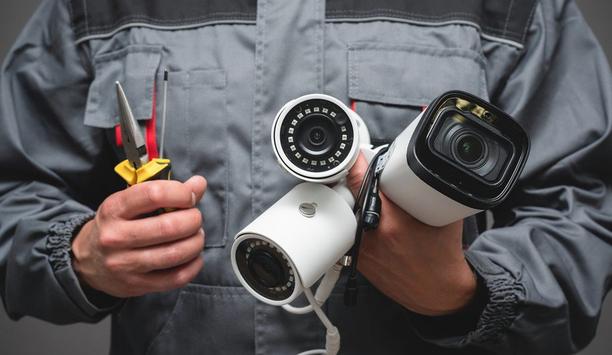
How to lower labour costs when installing video surveillance
Download
Total cost of ownership for video surveillance
Download
The truth behind 9 mobile access myths
Download
5 surprising findings from OT vulnerability assessments
Download
Guide for HAAS: New choice of SMB security system
Download
Precision and intelligence: LiDAR's role in modern security ecosystems
Download
Using artificial intelligence (AI) to automate physical security systems
Download
Palm vein recognition
Download
Physical access control
Download
The 2024 state of physical access trend report
Download
The security challenges of data centers
Download
Security practices for hotels
Download
Access control system planning phase 2
Download
Honeywell GARD USB threat report 2024
Download
Access control system planning phase 1
Download
How to lower labour costs when installing video surveillance
Download
Total cost of ownership for video surveillance
Download
The truth behind 9 mobile access myths
Download
5 surprising findings from OT vulnerability assessments
Download
Guide for HAAS: New choice of SMB security system
Download
Precision and intelligence: LiDAR's role in modern security ecosystems
Download
Using artificial intelligence (AI) to automate physical security systems
Download
Palm vein recognition
Download
Physical access control
Download
The 2024 state of physical access trend report
Download
The security challenges of data centers
Download
Security practices for hotels
Download
Access control system planning phase 2
Download
Honeywell GARD USB threat report 2024
Download


Using artificial intelligence (AI) to automate physical security systems
Download
A modern guide to data loss prevention
Download
7 proven solutions for law enforcement key control and asset management
Download
The truth behind 9 mobile access myths
Download
Access control system planning phase 2
Download











